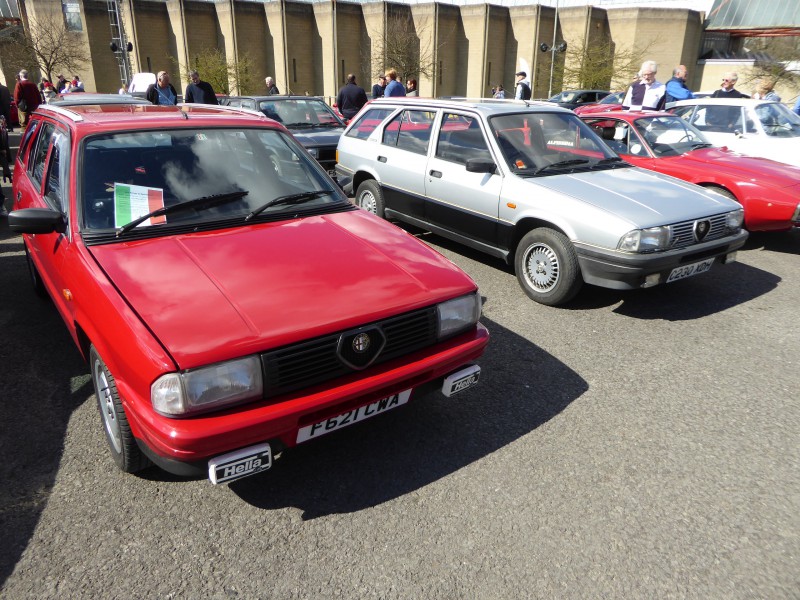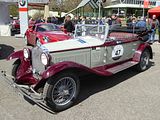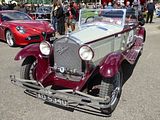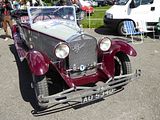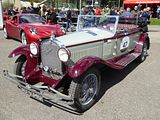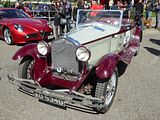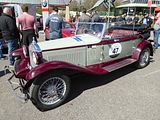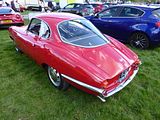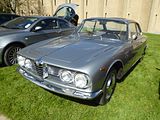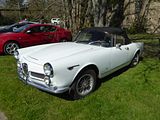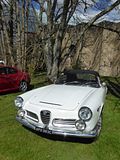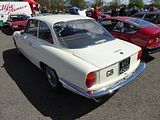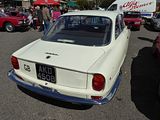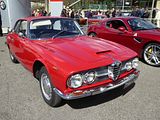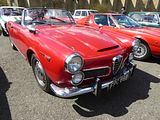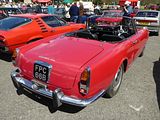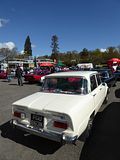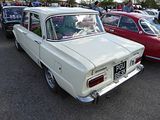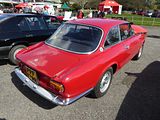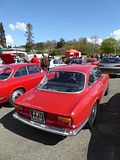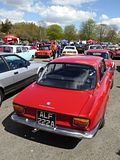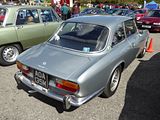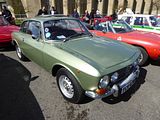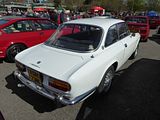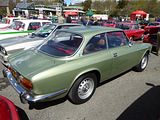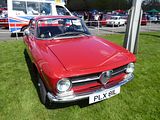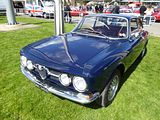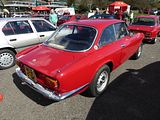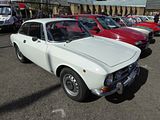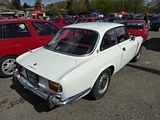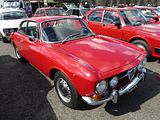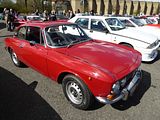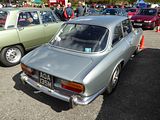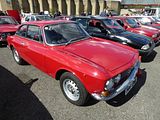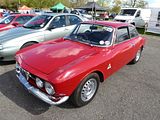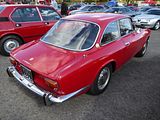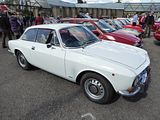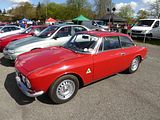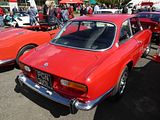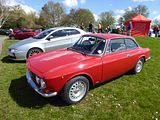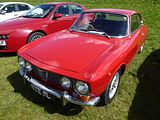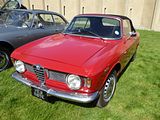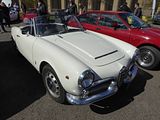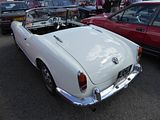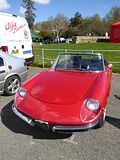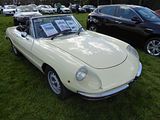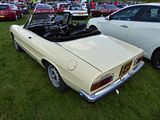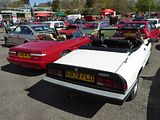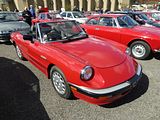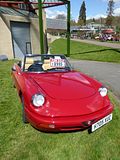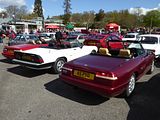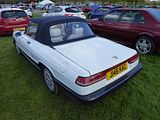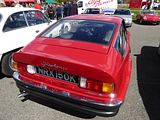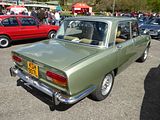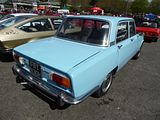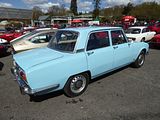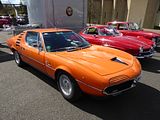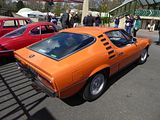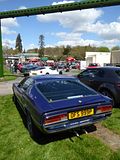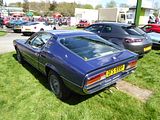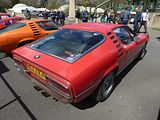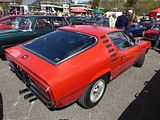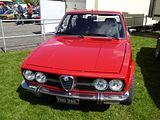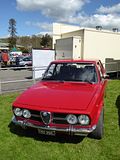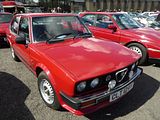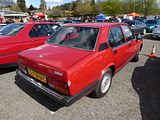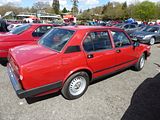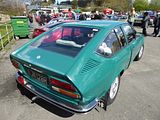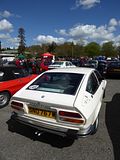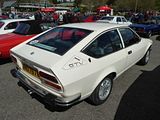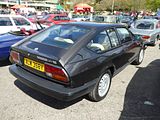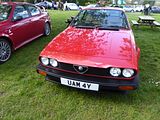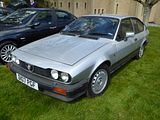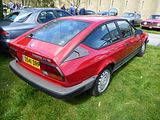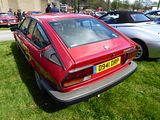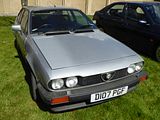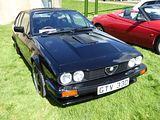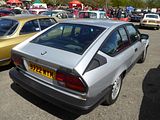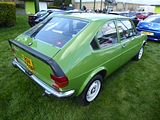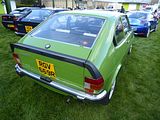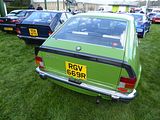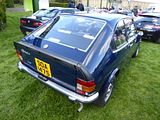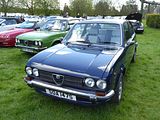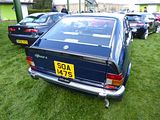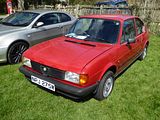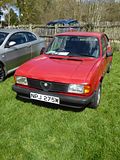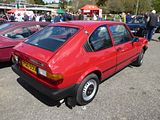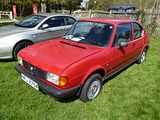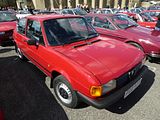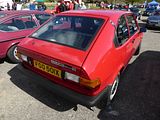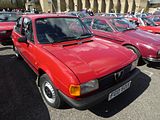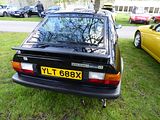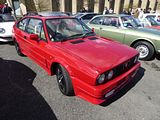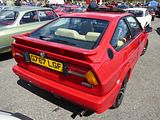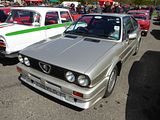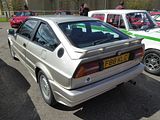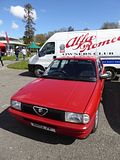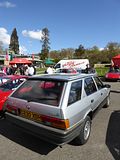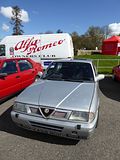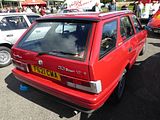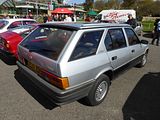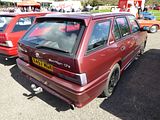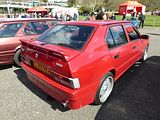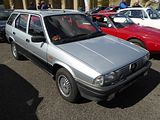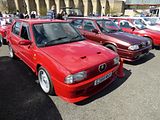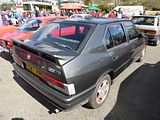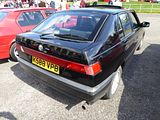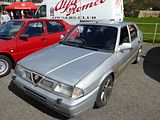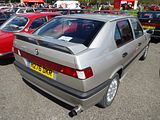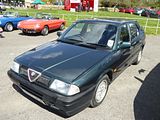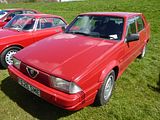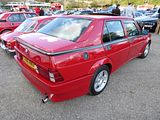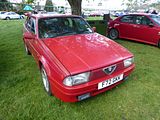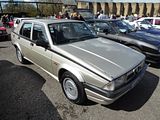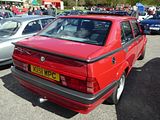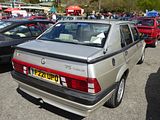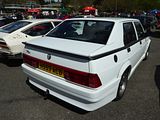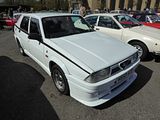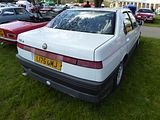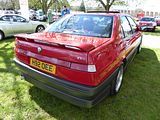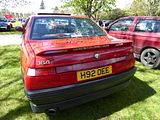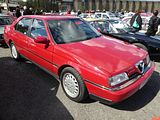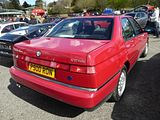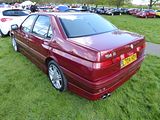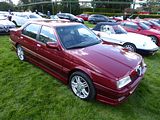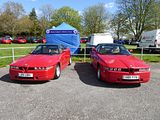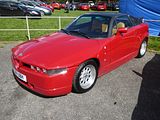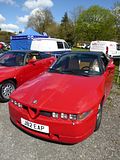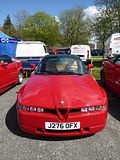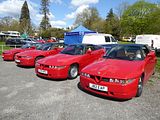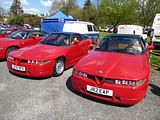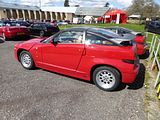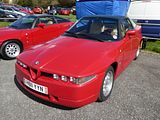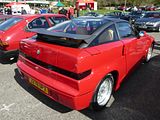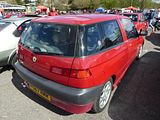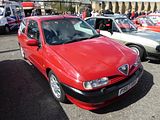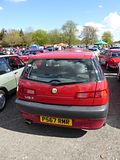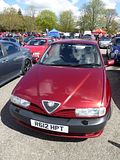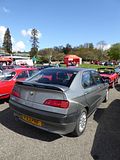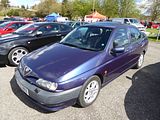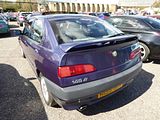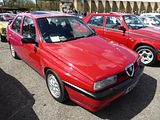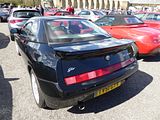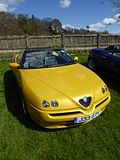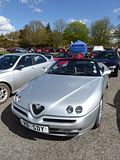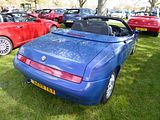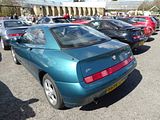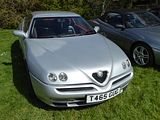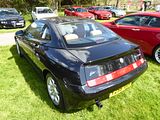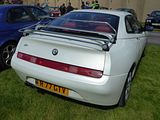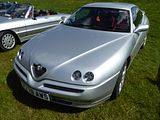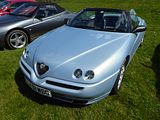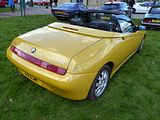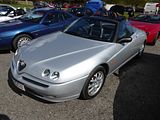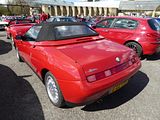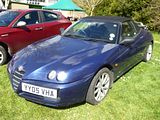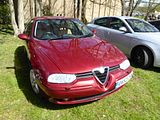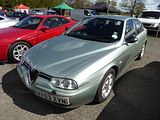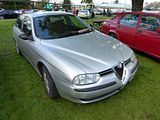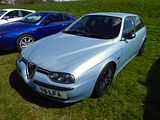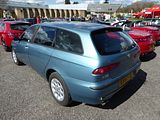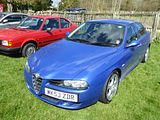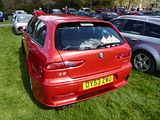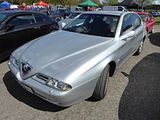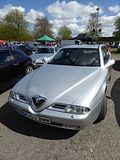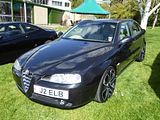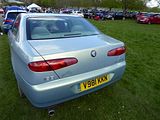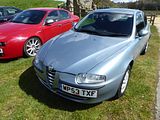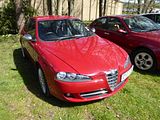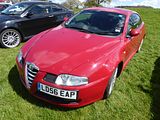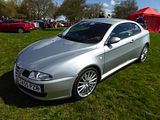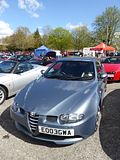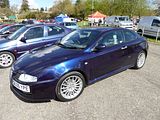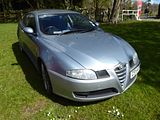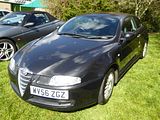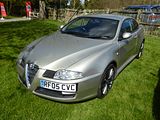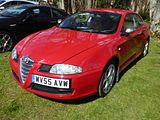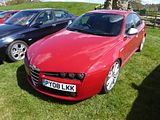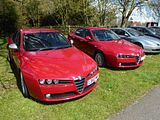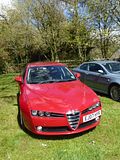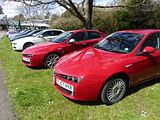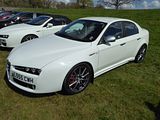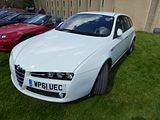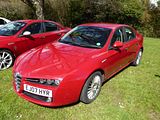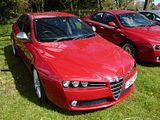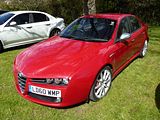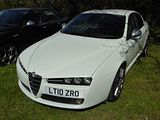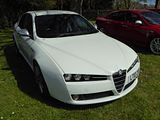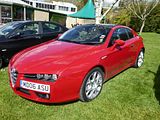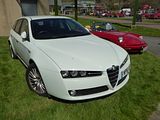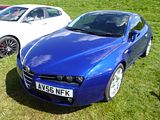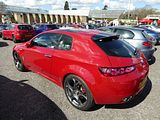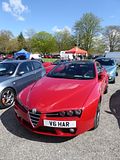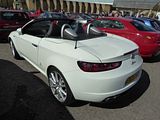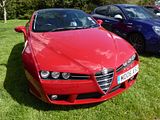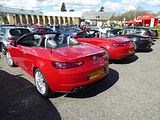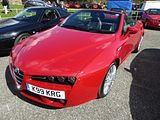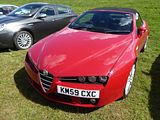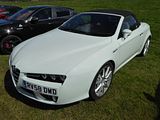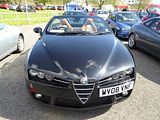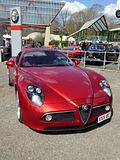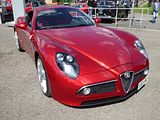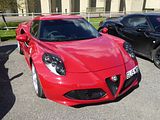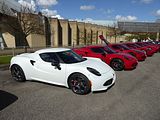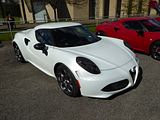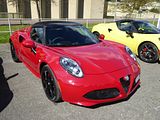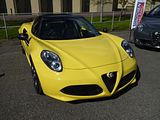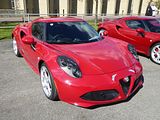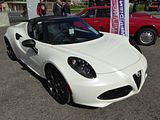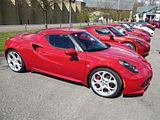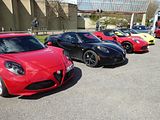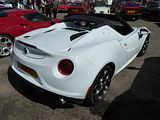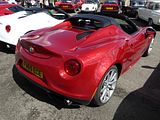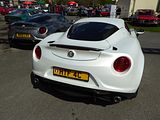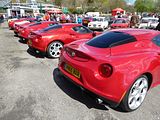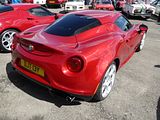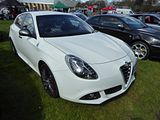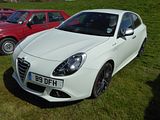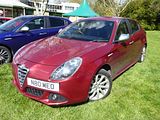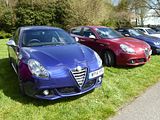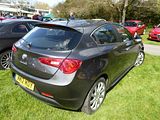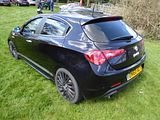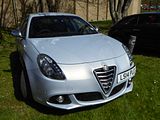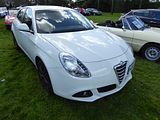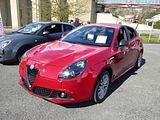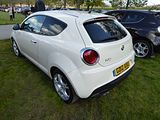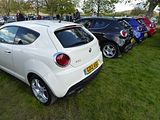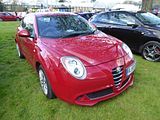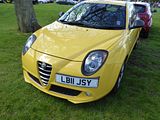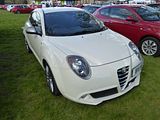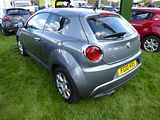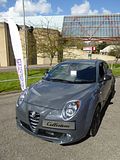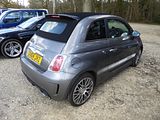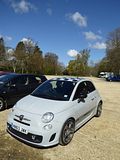With the new rear wheel drive Giulia saloon due to reach the showrooms later this year, the motoring press are once again – despite many of them saying they are trying to not to write such words – dusting off time honoured phrases about how Alfa has a glorious heritage but that recently, successive models have disappointed and that the latest car is the “last chance” for survival. Owners and fans of the marque – of which there are many – would, of course, beg to differ. Marque sales may have fallen somewhat in recent years, but that’s hardly surprising as since the end of production of the 159, Brera, Spider and GT models in 2011, the range has only comprised two models and the halo 4C Competizione. And yet, enthusiasm and passion for the marque shows no sign of diminishing. You only have to go to any gathering of Italian cars to remind yourself of that, as Alfa Romeos tend to be the dominant marque, outnumbering Fiat, Lancia, Abarth and the exotics. Alfa owners manifest a passion for the brand that you just don’t find among those who drive the latest German premium marques, and if you really want the evidence of that, then an Alfa Romeo Owners Club meeting will leave you in no doubt. So large is this Club that it has a significant number of regional operations, many of which are sizeable clubs in their own right. Many of them organise their own meetings, and some of the more centrally based ones also take it in turns to organise one of the national event. One of the biggest of these is the Spring Alfa event, which moves around the country. I last attended this in 2010, when it was held at Burghley House, and thoroughly enjoyed it. A combination of diary pressures and the chosen location of subsequent events mean that I have not managed to make a return visit, but for 2016, I spotted that the event would take place in the grounds of the National Motor Museum at Beaulieu. With a loan car lined up to test as potential replacement for my trust Audi S5, it seemed like a perfect destination, made all the better when I saw the forecast was for a gloriously sunny spring day. And so it turned out to be. That, I am sure, encouraged a particularly good turn out. I understand that over 900 tickets were sold through the Ala Owners Club, at least 600 of which were for Alfa owners, and certainly when I arrived at around 10am, there were plenty of cars parked up, and there was a long queue of more waiting to have their tickets checked and to take their place. lndeed, there was so much to see and enjoy that I never managed to get into the Museum at all during my visit. There were a few models – generally the ones with single digit survival rates – that were unrepresented, but most models from the past 60 years were here, making this a splendid presentation of the history of Alfa. Here are the highlights as recorded by my camera.
6C1750
There was only one pre-war model present, and it was this one, an example of the 6C 1750 that I’ve not seen before. Most of the time we see 6C 1750 models with Touring and Zagato bodies which were used for racing. These are known as the Gran Sport cars, but Alfa did also produce a version for road-going clientele, the Gran Turismo, a detuned version of the successful Gran Sport race car. These were sold for customers requesting saloon and cabriolet bodies. Having the same DOHC engine, the Gran Turismo was a high specification road car that shadowed performance of the Mille Miglia-winning 1750. This model first appeared in 1929 as the 6C 1750 Sport and was renamed Gran Turismo for the 4th and 5th-series cars. A lower specification model simply known as the Turismo was offered which used a SOHC version of the engine for reduced overall cost. I think that this model has a James Young body on it, but despite trying to find any proof of this (or information to correct me), I am still in the realm of speculation about that fact. Any updates welcome!
101 SERIES GIULIETTA
Alfa’s first “regular” production car was the 1900 Saloon of 1951. There were no examples of that model here, which is not entirely surprising, as there are only a handful of the model in the UK. But the family of cars that joined it were represented. This was the Giulietta, the 750 and later 101 Series, a family car made from 1954 to 1965, and Alfa Romeo’s first, successful, foray into the 1.3-litre class. A total of 177,690 Giuliettas were made, the great majority in Berlina saloon, Sprint coupé or Spider roadster body styles, but there were also Sprint Speciale and Sprint Zagato coupés, and the very low volume Promiscua estate. The first Giulietta to be introduced was the Giulietta Sprint 2+2 coupé which was premiered at the 1954 Turin Motor Show. The Sprint had been designed by Franco Scaglione at Bertone, and it was produced at the coachbuilder’s Grugliasco plant, near Turin. A year later, at the Turin Motor Show in April 1955, the Sprint was joined by the 4-door saloon Berlina. In mid 1955, the open two-seat Giulietta Spider, featuring convertible bodywork by Pininfarina arrived. The Giulietta used unibody construction and a front-engine, rear-wheel-drive layout. Front suspension was by control arms, with coaxial coil springs and hydraulic dampers. At the rear there was a solid axle on coil springs and hydraulic dampers. The axle was located by a longitudinal link on each side, and by a wishbone-shaped arm linking the top of the aluminium differential housing to the chassis. All Giuliettas (save for the last SZ examples) had hydraulic drum brakes on all four corners. When leaving the Portello factory it originally fitted Pirelli Cinturato 155 HR15 tyres (CA67). The Giulietta used an Alfa Romeo Twin Cam straight-four of 1290 cc, with an aluminium alloy engine block and cast iron inserted sleeves. Bore and stroke measured 74.0 mm and 75.0 mm. The aluminium alloy cylinder head was of a crossflow design and featured hemispherical combustion chambers. The double overhead camshafts were driven by two timing chains, and acted on two valves per cylinder, angled 80°. In 1957 a more powerful Berlina version, called Giulietta T.I. (Turismo Internazionale) was presented with minor cosmetic changes to the bonnet, the dial lights and rear lamps. Carrozzeria Colli also made the Giulietta station wagon variant called Giulietta Promiscua. Ninety-one examples of this version were built. Carrozzeria Boneschi also made a few station wagon examples called Weekendina. new version of the Giulietta Berlina debuted at the Frankfurt Motor Show in 1959. Mechanical changes were limited to shifting the fuel pump from the cylinder head to a lower position below the distributor, and moving the previously exposed fuel filler cap from the tail to the right rear wing, under a flap. The bodywork showed a revised front end, with more rounded wings, recessed head lights, and new grilles with chrome frames and two horizontal bars. The rear also showed changes, with new larger tail lights on vestigial fins, which replaced the earlier rounded rear wings. The interior was much more organised and upholstered in new cloth material; the redesigned dashboard included a strip speedometer flanked by two round bezels, that on the T.I. housed a tachometer and oil and water temperature gauges. The T.I. also received a front side repeater mounted in a small spear, unlike the Normale which kept the earlier small round lamp with no decorations. During 1959 the type designation for all models was changed from 750 and 753 to 101. In February 1961 the 100,001st Giulietta rolled off the Portello factory, with a celebration sponsored by Italian actress Giulietta Masina. In Autumn 1961 the Giulietta was updated a second time. Both Normale and T.I. had revised engines and new exhaust systems; output rose to 61 bhp and 73 bhp. With this new engine the car could reach a speed of almost 100mph. At the front of the car square mesh side grilles were now pieced together with the centre shield, and at the rear there were larger tail lights. Inside the T.I. had individual instead of bench seats, with storage nets on the seatbacks. June 1962 saw the introduction of the Alfa Romeo Giulia, which would eventually replace the Giulietta. As until 1964 the Giulia only had a larger 1.6-litre engine, production of the standard Berlina ended with 1963, whilst the T.I. continued for a full year more. A last T.I. was completed in 1965. The Giulietta sport models had a different fate: Sprint, Sprint Speciale and Spider were fitted with the new 1.6-litre engine, received some updates and continued to be sold under the Giulia name until they were replaced by all-new Giulia-based models during 1965. These days., the Berlina is the model you see the least often. A few of the model are used in historic racing where the car takes on the might of those with far larger engines. This is one of just a handful of road-going Berlina models in the UK.
There was a second Coupe model in the Giulietta range. Known as the SS, or Sprint Speciale, it really does live up to the name, as it is rather special. The Sprint Speciale was first shown at the 1957 Turin Show as a prototype. Production cars were launched at the Monza circuit in June 1959. The SS boasted the lowest drag coefficient ever seen in a production car, with a cd of just 0.28, a figure which was not surpassed for 20 years. In 1963, it was updated, taking the Giulia name, when a larger 1600cc engine was put under the bonnet, giving it a top speed of 120 mph, an astonishing figure at the time. It did not come cheap, though, costing a lot more than the Giulia GT that was also first shown in 1963. 1,366 of the earlier Giulietta Sprint Speciale and 1,400 of the later Giulia Sprint Speciale were produced before production ceased in 1963. Just 25 cars were converted to right hand drive by RuddSpeed. You don’t see these cars very often, and of the ones I recall seeing in the past few years, they have all been Giulia versions, so it was a pleasant surprise to come across this Giulietta version.
2000 and 2600 – 102 and 106 SERIES
Alfa followed up the Giulietta with a larger car, designed to replace the 1900, the 102 Series cars and called the 2000. Launched in 1958, it was with these models that Alfa marked the brand’s transition from being a maker of exclusive coachbuilt and racing cars to one that offered volume production models. The 102 was never likely to be a big seller, in a world that was still recovering economically from the ravages of the Second World War, but it was an important flagship, nonetheless. The 2000 models ran for 4 years, from 1958 to 1962, at which point they were updated, taking on the name of 106 Series, with minor styling changes being accompanied by a larger 2600cc engine under the bonnet. As with the 2000 models, the new 2600 cars were sold in Berlina (Saloon), Sprint (Coupe) and Spider (Convertible) versions, along with a dramatically styled SZ Coupe from Italian styling house Zagato and a rebodied Berlina from OSI, all of them with an inline twin overhead cam six cylinder engine of 2.6 litres, the last Alfas to offer this configuration. Just 6999 of the Sprint models were made and 2255 Spiders, very few of which were sold new in the UK where they were exceedingly expensive thanks to the dreaded Import Duty which made them much more costly than an E Type. Many of the parts were unique to these cars, so owning one now is far harder than the more plentiful 4 cylinder Alfas of the era. Whilst the rather square styling of the Berlina, which won it relatively few friends when new and not a lot more in recent times means that there are few of these versions to be seen, the Sprint and Spider models do appear from time to time, and market interest in the cars is now starting to accelerate, with values rise accordingly. Seen here were a 2000 Coupe and both the Coupe and Spider versions of the 2600, all of which I think look absolutely fantastic. The cars had a strong domestic rival in the form of the Lancia Flaminia and an article in “Classic and Sports Car” magazine last year compared the two. It concluded (reluctantly, given the declared bias of the author) that the contemporary Lancia Flaminia was actually the better car, but I could quite understand why anyone would fall for the Alfa cars.
GIULIA – 105 SERIES
First up in the 105 Series of cars, known as the Giulia, because it was larger than the Giulietta, was the Berlina model launched in 1962. The Giulia was produced from 1962 to 1978 in a bewildering array of similar models, which even the marque enthusiast can find hard to untangle. The styling was quite straight forward, but great attention was paid to detail. The engine bay, cabin and boot were all square shaped. But the grille, the rooflines and details on the bonnet and boot made for an integrated design from bumper to bumper. Thanks to Alfa Romeo using a wind tunnel during its development, the Giulia was very aerodynamic with a drag coefficient of Cd=0.34, which was particularly low for a saloon of the era and not a bad figure even for cars of today. Couple that with the fact that Alfa Romeo was one of the first manufacturers to put a powerful engine in a light-weight car (it weighed about 1,000 kilograms) and thanks to an array of light alloy twin overhead camshaft four-cylinder engine, similar to that of the earlier Giulietta models range, the car had a lively performance which bettered that of many sports cars of the day. The Tipo 105.14 was the first model introduced in 1962. with a 1,570 cc Twin Cam engine with single down-draft carburettor generating 91 hp at 6500 rpm. The “TI” nomenclature referred to a class of Italian saloon car racing known as “Turismo Internazionale”, and had previously been applied to higher-performance versions of the 1900 and Giulietta saloons in the 1950s. However, for the Giulia saloon, the Ti was at first the only version available, and later, with the introduction of the TI Super and Super, the TI became the base version for the 1,600 cc engine class. The steering column gearchange (the only one in the Giulia range) was replaced with a floor change for 1964 (Tipo 105.08). Right hand drive cars, available from 1964, only ever had a floor change (Tipo 105.09). Brakes were by drums all around at first. Discs were introduced later, first at the front, and later all around. A brake servo was not fitted at first, but was introduced in later cars. The steering wheel featured the only horn ring ever in the Giulia range. The dashboard with a strip speedo is a notable feature, as is the steering wheel with a horn ring. The Giulia TI was phased out in 1968 and re-introduced as the austerity model 1600 S. Tipo 105.16 was a special racing model introduced in 1963. Quadrifoglio Verde stickers on the front wings were a distinguishing feature. Only 501 were made for homologation and today it is very rare and desirable. The 1,570 cc engine was fitted with two double-choke horizontal Weber 45DCOE carburettors for 110 hp at 6500 rpm. The body was lightened and a floor gearchange was fitted as standard, as were alloy wheels of very similar appearance to the standard steel ones of the TI. The TI’s instrument cluster with its strip speedometer was replaced with a three-instrument binnacle comprising speedometer, tachometer and a multi-gauge instrument (fuel, water temperature, oil temperature and pressure) – these instruments were similar to those fitted to the contemporary Giulia Sprint and Sprint Speciale coupes and Spider convertibles. The steering wheel was a three-spoke item with centre hornpush, also similar to that of the more sporting models. Braking was by discs all around, although the first cars used drums (triple leading shoe on the front) and early disc models lacked a servo which was introduced later. The police cars seen in The Italian Job were of this type. Tipo 105.06 was an austerity model made from 1964 to 1970 with a 1,290 cc single-carburettor engine for 77 hp at 6000 rpm. Four-speed gearbox with floor change fitted as standard (the 1300 was the only Giulia model not fitted with a five-speed gearbox). Though the engine was given a 105 series type number, it was basically the engine from the 101 series Giulietta Ti. This model appears not to have been exported to many markets outside Italy, if at all. Braking was by discs all around, without a servo at first, later with a servo. Tipo 105.26 was introduced in 1965. It transferred the technology from the racing TI Super to a road car, to make the most successful Giulia saloon. 1,570 cc engine with two double-choke Weber 40DCOE carburettors for a milder, but torquier tune than the TI Super – 97 hp at 5500 rpm. There was a new dashboard with two large round instruments and clock, a sportier steering wheel with three aluminium spokes and centre horn push, similar to that of the Ti Super, later changed for one with the horn pushes in the spokes. All-around disc brakes with servo were fitted as standard from the outset. The serpent crest of the Sforza family appears in a badge on the C-pillar and is a distinguishing feature of the Super. For 1968, there was a suspension update, including revised geometry and a rear anti-roll bar. The wheels were changed from 155/15 to 165/14. For 1970, updates included dual-circuit brakes, centre-mounted handbrake lever to replace under-dash “umbrella handle”, larger external doorhandles, and top-hinged pedals (the latter in left hand drive models only; right hand drive continued with bottom-hinged pedals to the end of production). In 1972, Tipo 105.26 was rationalised into the Giulia 1.3 – Giulia 1.6 range. Tipo 105.39 built from 1965 to 1972. Right hand drive model replaced in 1970 by the 1300 Super. 1,290 cc engine with single down-draft carburettor for 81 hp at 6000 rpm. Unlike the re-deployed 101-series Giulietta engine of the austerity-model 1300, the 1300 ti motor was a 105 series engine, basically that of the sportier GT1300 Junior coupe with different camshaft timing (but the same camshafts) and induction system. Five-speed gearbox. Three-spoke bakelite steering wheel with plastic horn push covering the centre and spokes. Dashboard initially with strip speedo like that of the TI. For 1968, updates included a dashboard based on that of the Super, but with a simpler instrument binnacle, still featuring two large round instruments (speedo and tacho) and a separate fuel gauge, and the same suspension, wheel and tire updates applied to the Giulia Super in the same year. For 1970, updates included dual-circuit brakes, centre handbrake, larger external doorhandles and top-hinged pedals (on left hand drive cars only), again as applied to the Super for that year. Tipo 105.85 was basically a Giulia TI re-introduced in 1968 as a lower-level model to come between the 1300 and 1300 ti on one hand, and the Super on the other. It had a re-interpretation of the 1,570 cc single-carburettor engine for 94 hp at 5500 rpm and similar trim to the 1300 ti. Replaced in 1970 by the 1300 Super (see below) which offered similar performance in a lower tax bracket. The last cars from 1970 featured the top-hinged pedals, centre handbrake and dual-circuit brakes as for the Super and 1300 ti. Tipo 115.09 was introduced in 1970. It was basically a 1300 ti fitted with the engine from the GT 1300 Junior coupe that featured two double-choke horizontal carburettors; the engine actually had the GT 1300 Junior type number. This model was rationalised into the Giulia Super 1.3 – Giulia Super 1.6 range in 1972. In 1972 a rationalisation of the Giulia range saw the Super 1300 (Tipo 115.09) and the Super (Tipo 105.26) re-released as the Super 1.3 and Super 1.6. The two models featured the same equipment, interior and exterior trim, differing only in engine size (1,290 cc and 1,570 cc) and final drive ratio. The 1300 ti was dropped. A small Alfa Romeo badge on the C-pillar is a distinguishing feature, as are hubcaps with exposed wheel nuts. In December 1972 Alfa-Romeo South Africa released the 1600 Rallye. This locally developed more powerful 1600 cc version of the 1300 Super, using the 1300’s single-headlight body shell. The car was largely ready for competition and was only planned to be built in limited numbers, and was fitted with racing-style rear-view mirrors, rally lamps, fully adjustable seats, and a limited-slip differential. Claimed power was 125 hp. The Giulia Super range was re-released in 1974 as the Nuova Super range, including the Giulia Nuova Super 1300 and 1600 This and featured a new black plastic front grille and a flat boot lid without the characteristic centre spine. Otherwise the cars differed little from their Giulia Super predecessors and bore the same Tipo numbers with an S suffix. A Nuova Super fitted with a Perkins 1,760 cc diesel with 54 hp at 4000 rpm, the firm’s first attempt at diesel power. The same Perkins diesel was used also in Alfa Romeo F12 van. The diesel version was slow, 138 km/h (86 mph), and the engine somehow unsuitable for a sport sedan so it was not big seller, only around 6500 examples were made in 1976 and the car was not sold in the UK. Production of the Giulia ceased in 1977. There are relatively few of these cars in the UK, and many of these are left hand drive models which have been re-imported relatively recently.
A Coupe model followed a year later. It also evolved over a 14 year production life, though its history is rather easier to understand. The first car was called the Alfa Romeo Giulia Sprint GT. It was revealed at a press event held at the then newly opened Arese plant on 9 September 1963, and displayed later the same month at the Frankfurt Motor Show. In its original form the Bertone body is known as scalino (step) or “step front”, because of the leading edge of the engine compartment lid which sat 1/4 an inch above the nose of the car. The Giulia Sprint GT can be distinguished from the later models by a number of features including: Exterior badging: Alfa Romeo logo on the front grille, a chrome script reading “Giulia Sprint GT” on the boot lid, and rectangular “Disegno di Bertone” badges aft of the front wheel arches; flat, chrome grille in plain, wide rectangular mesh without additional chrome bars; single-piece chrome bumpers; no overriders. Inside the cabin the padded vinyl dashboard was characterised by a concave horizontal fascia, finished in grey anti-glare crackle-effect paint. Four round instruments were inset in the fascia in front of the driver. The larger diameter inner pair were tachometer and speedometer; the outer ones were smaller combination instruments, the left hand one holding oil pressure and fuel level gauges, the right hand one oil and water temperature gauges. The steering wheel was non-dished, with three aluminium spokes, a thin bakelite rim and a centre horn button. Vinyl-covered seats with cloth centres and a fully carpeted floor were standard, while leather upholstery was an extra-cost option. After initially marketing it as a four-seater, Alfa Romeo soon changed its definition of the car to a more realistic 2+2. The Giulia Sprint GT was fitted with the 1,570 cc displacement version of Alfa Romeo’s all-aluminium twin cam inline four, which had first debuted on the 1962 Giulia Berlina. Breathing through two twin-choke Weber 40 DCOE 4 carburettors, on the Sprint GT this engine produced 105 hp at 6,000 rpm. Like all subsequent models, the Sprint GT was equipped with an all-synchromesh 5-speed manual transmission. The braking system comprised four Dunlop disc brakes and a vacuum servo. The rear brakes featured an unusual arrangement with the slave cylinders mounted on the axle tubes, operating the calipers by a system of levers and cranks. According to Alfa Romeo the car could reach a top speed of “over 180 km/h (112 mph)”. In total 21,902 Giulia Sprint GT were produced from 1963 to 1965, when the model was superseded by the Giulia Sprint GT Veloce. Of these 2,274 were right hand drive: 1,354 cars fully finished in Arese, and 920 shipped in complete knock-down kit form for foreign assembly. For 1966, the Giulia Sprint GT was replaced by the Alfa Romeo Giulia Sprint GT Veloce, which was very similar but featuring a number of improvements: a revised engine—slightly more powerful and with more torque—better interior fittings and changes to the exterior trim. Alongside the brand new 1750 Spider Veloce which shared its updated engine the Sprint GT Veloce was introduced at the 36th Geneva Motor Show in March 1966, and then tested by the international specialist press in Gardone on the Garda Lake. Production had began in 1965 and ended in 1968. The Giulia Sprint GT Veloce can be most easily distinguished from other models by the following features: badging as per Giulia Sprint GT, with the addition of round enamel badges on the C-pillar—a green Quadrifoglio on an ivory background—and a chrome “Veloce” script on the tail panel; black mesh grille with three horizontal chrome bars; the grille heart has 7 bars instead of 6; stainless steel bumpers, as opposed to the chromed mild steel bumpers on the Giulia Sprint GT. The bumpers are the same shape, but are made in two pieces (front) and three pieces (rear) with small covers hiding the joining rivets. Inside the main changes from the Giulia Sprint GT were imitation wood dashboard fascia instead of the previous anti-glare grey finish, front seats revised to a mild “bucket” design, and a dished three aluminium spoke steering wheel, with a black rim and horn buttons through the spokes. The Veloce’s type 00536 engine, identical to the Spider 1600 Duetto’s, featured modifications compared to the Giulia Sprint GT’s type 00502—such as larger diameter exhaust valves. As a result it produced 108 hp at 6,000 rpm, an increase of 3 hp over the previous model, and significantly more torque. According to the manufacturer top speed now exceeded 185 km/h (115 mph). Early Giulia Sprint GT Veloces featured the same Dunlop disc brake system as the Giulia Sprint GT, while later cars substituted ATE disc brakes as pioneered on the GT 1300 Junior in 1966. The ATE brakes featured an handbrake system entirely separate from the pedal brakes, using drum brakes incorporated in the rear disc castings. Though the Sprint GT Veloce’s replacement—the 1750 GT Veloce—was introduced in 1967, production continued throughout the year and thirty final cars were completed in 1968. By then total Giulia Sprint GT Veloce production amounted to 14,240 examples. 1,407 of these were right hand drive cars, and 332 right hand drive complete knock-down kits. The Alfa Romeo 1750 GT Veloce (also known as 1750 GTV) appeared in 1967 along with the 1750 Berlina sedan and 1750 Spider. The same type of engine was used to power all three versions; this rationalisation was a first for Alfa Romeo. The 1750 GTV replaced the Giulia Sprint GT Veloce and introduced many updates and modifications. Most significantly, the engine capacity was increased to 1779 cc displacement. Peak power from the engine was increased to 120 hp at 5500 rpm. The stroke was lengthened from 82 to 88.5 mm over the 1600 engine, and a reduced rev limit from 7000 rpm to 6000 rpm. Maximum torque was increased to 186 N·m (137 lb·ft) at 3000 rpm. A higher ratio final drive was fitted (10/41 instead of 9/41) but the same gearbox ratios were retained. The result was that, on paper, the car had only slightly improved performance compared to the Giulia Sprint GT Veloce, but on the road it was much more flexible to drive and it was easier to maintain higher average speeds for fast touring. For the United States market, the 1779 cc engine was fitted with a fuel injection system made by Alfa Romeo subsidiary SPICA, to meet emission control laws that were coming into effect at the time. Fuel injection was also featured on Canadian market cars after 1971. Carburettors were retained for other markets. The chassis was also significantly modified. Tyre size went to 165/14 from 155/15 and wheel size to 5 1/2J x 14 instead of 5J x 15, giving a wider section and slightly smaller rolling diameter. The suspension geometry was also revised, and an anti-roll bar was fitted to the rear suspension. ATE disc brakes were fitted from the outset, but with bigger front discs and calipers than the ones fitted to GT 1300 Juniors and late Giulia Sprint GT Veloces. The changes resulted in significant improvements to the handling and braking, which once again made it easier for the driver to maintain high average speeds for fast touring. The 1750 GTV also departed significantly from the earlier cars externally. New nose styling eliminated the “stepped” bonnet of the Giulia Sprint GT, GTC, GTA and early GT 1300 Juniors and incorporated four headlamps. For the 1971 model year, United States market 1750 GTV’s also featured larger rear light clusters (there were no 1970 model year Alfas on the US market). Besides the chrome “1750” badge on the bootlid, there was also a round Alfa Romeo badge. Similar Quadrofoglio badges to those on the Giulia Sprint GT Veloce were fitted on C pillars, but the Quadrofoglio was coloured gold instead of green. The car also adopted the higher rear wheelarches first seen on the GT 1300 Junior. The interior was also much modified over that of earlier cars. There was a new dashboard with large speedometer and tachometer instruments in twin binnacles closer to the driver’s line of sight. The instruments were mounted at a more conventional angle, avoiding the reflections caused by the upward angled flat dash of earlier cars. Conversely, auxiliary instruments were moved to angled bezels in the centre console, further from the driver’s line of sight than before. The new seats introduced adjustable headrests which merged with the top of the seat when fully down. The window winder levers, the door release levers and the quarterlight vent knobs were also restyled. The remote release for the boot lid, located on the inside of the door opening on the B-post just under the door lock striker, was moved from the right hand side of the car to the left hand side. The location of this item was always independent of whether the car was left hand drive or right hand drive. Early (Series 1) 1750 GTV’s featured the same bumpers as the Giulia Sprint GT Veloce, with the front bumper modified to mount the indicator / sidelight units on the top of its corners, or under the bumper on US market cars. The Series 2 1750 GTV of 1970 introduced other mechanical changes, including a dual circuit braking system (split front and rear, with separate servos). The brake and clutch pedals on left hand drive cars were also of an improved pendant design, instead of the earlier floor-hinged type. On right hand drive cars the floor-hinged pedals were retained, as there was no space for the pedal box behind the carburettors. Externally, the series 2 1750 GTV is identified by new, slimmer bumpers with front and rear overriders. The combined front indicator and sidelight units were now mounted to the front panel instead of the front bumper, except again on the 1971-72 US/Canadian market cars. The interior was slightly modified, with the seats retaining the same basic outline but following a simpler design. 44,269 1750 GTVs were made before their replacement came along. That car was the 2000GTV. Introduced in 1971, together with the 2000 Berlina sedan and 2000 Spider, the 2 litre cars were replacements for the 1750 range. The engine displacement was increased to 1962 cc. Oil and radiator capacities remained unchanged. The North American market cars had fuel injection, but everyone else retained carburettors. Officially, both versions generated the same power, 130 hp at 5500 rpm. The interior trim was changed, with the most notable differences being the introduction of a separate instrument cluster, instead of the gauges installed in the dash panel in earlier cars. Externally the 2000 GTV is most easily distinguished by its grille with horizontal chrome bars, featuring protruding blocks forming the familiar Alfa heart in outline, smaller hubcaps with exposed wheel nuts, optional aluminium alloy wheels of the same size as the standard 5. 1/2J × 14 steel items, styled to the “turbina” design first seen on the alloy wheels of the Alfa Romeo Montreal, and the larger rear light clusters first fitted to United States market 1750 GTV’s were standard for all markets. From 1974 on, the 105 Series coupé models were rationalised and these external features became common to post-1974 GT 1300 Junior and GT 1600 Junior models, with only few distinguishing features marking the difference between models. 37,459 2000 GTVs were made before production ended and these days they are very sought after with prices having sky-rocketed in recent years.
Based on the Coupe, but with a model designation of its own, was the GTC, a stunningly pretty open topped model which was only produced for a year in 1965, in very limited numbers making them rare today with a total production of just 1000 cars in right and left hand drive versions. Only 99 were made for the British and South African market. It was based on the Giulia Sprint GT, with the cabriolet modification carried out by Touring of Milan. Besides the cabriolet top, a distinguishing feature is the dashboard finished in black instead of grey crackle. The model was badged with a script reading “Giulia Sprint GTC” on the bootlid. To restore some of the bodyshell rigidity lost by removing the fixed roof and pillars, Carrozzeria Touring added reinforcement to several areas of the bodyshell. Through the production life of the model, several modifications to the reinforcement applied were made by Touring, apparently in an effort to improve the stiffening achieved. Carrozzeria Touring was in financial trouble when the Giulia Spring GTC went into production. The company went out of business shortly after production of this model ended.
Following the 1962 launch of the 105-series Giulia, which first complemented and then replaced the 101-series Giulietta, the sport variants of the Giulietta remained on sale for several more years, upgraded to the Giulia’s 1.6-litre engine and rebadged Giulia, until variants of the new models were ready. Thus the Giulietta-based Giulia Spider 1600 and Giulia Spider Veloce were produced from 1962 to 1965 and from 1963 to 1965 respectively and there was an example of such a Spider model here.
The original 1966 Spider shape was the result of a number of Pininfarina design studies, concept cars showing traits incorporated in the final production design. The first one was the Alfa Romeo Superflow, a concept car built upon the chassis of a retired 6C 3000 CM racing car and first show at the 1956 Turin Motor Show. Despite being an aerodynamic coupé with prominent fins on the rear, and a futuristic all-plexiglas greenhouse and front wings, the Superflow already shown the overall body shape of the future Spider and the scallops on the sides. In the following years the Superflow was updated three times into three more different concept cars, namely a Superflow II coupé, then an open-top spider and finally another Superflow IV coupé. The most significant in the Spider’s design history was the second, the open-top Alfa Romeo Spider Super Sport, shown at the 1959 Geneva Motor Show. It did without the rear fins of the Superflow and Superflow II, showing for the first time the rounded cuttlebone-shaped tail and tail light configuration of the Spider. Last of the Spider’s forerunner was the Alfa Romeo Giulietta SS Spider Aerodinamica, which premiered at the 1961 Turin Motor Show, and was based on the Giulietta Sprint Speciale. Very close to the shape of the production car, its main design differences were at the front, due to hideaway headlamps. Despite the almost final design being ready in 1961, the continuing success of existing models and the economic challenges facing Italy at the time meant that the first pre-launch production Spiders began to emerge from the Pininfarina production line only at the end of 1965. The Spider was launched at the 36th Geneva Motor Show in March 1966, together with the Giulia Sprint GT Veloce at an event organised in Gardone Riviera. To choose a name for the spider Alfa Romeo announced a write-in competition, offering an example of the new car as a prize. Over 100,000 ballots were sent in, the great majority from Italy; the winner was Guidobaldo Trionfi, a man from Brescia, who proposed the name Duetto (duet). However the Duetto name could not be officially adopted due to trademark issues, and the car was named simply Alfa Romeo Spider 1600. The Spider’s 1,570 cc twin cam engine had dual Weber two-barrel side-draft carburettors, and produced 108 hp. Sparsely fitted inside but including five speed manual transmission and disc brakes, the price on launch in Italy was 2,195,000 lire. In the United States the car sold for $3,950 (compared to $3,991 for a Lotus Elan and $2,607 for an MGB). In the United Kingdom the car’s price was close to a Jaguar E-Type. In January 1968 Alfa Romeo introduced to the press in Vietri sul Mare (Salerno) its 1750 line of cars, which included the new 1750 Berlina saloon, the Giulia Sprint-based 1750 GT Veloce coupé, and the Duetto-based 1750 Spider Veloce, which replaced the original Spider 1600. All were powered by the same engine, a new 1,779 cc, 116 hp version of the Alfa Romeo twin cam engine. Top speed rose to 190 km/h (118 mph).The car did not bear any Spider badging, just a “1750” script below the rear Alfa Romeo badge. During the production run, the front repeater lights were moved ahead of the wheel arches. While in Europe the 1750 was fitted with two twin horizontal carburettors, starting with model year 1969 models for the North American market had SPICA (Società Pompe Iniezione Cassani & Affini, a subsidiary of Alfa Romeo) mechanical fuel injection. According to Alfa Romeo engine output and performance were unchanged from the carburetted version. Modifications were also made to the suspension, brakes, electrics, wheels and tyres, though the car looked effectively the same. Visible differences were limited to the rear-view mirror repositioned to the door, and badging on the tail, which read “Alfa Romeo” and “iniezione” (injection). A new lower priced spider, the Spider 1300 Junior, was introduced in June 1968 alongside the GTA 1300 Junior competition coupé. Its 1,290 cc twin cam engine was the same used on the GT 1300 Junior coupé, and produced 88 hp. Top speed was 170 km/h (106 mph). From a mechanical standpoint the Junior differed from the 1750 only in engine displacement and output, while inside it lacked some features of the pricier model: namely opening quarter lights, centre console, and the three-spoke wood rimmed steering wheel, replaced by a two-spoke plastic rimmed one. From outside the Junior version could be recognised by its black-coloured lower front bumper and absence of plastic headlamp fairings. Due to the shape of its long, round tail, the Series 1 Spider is sometimes known by the nickname of “Osso di seppia” (Italian for cuttlebone) or “boat tail” to differentiate it from the “Kamm tail” Series 2. A 1966 Alfa Romeo Spider 1600 is famously featured in the 1967 hit film The Graduate, starring Dustin Hoffman, Katharine Ross and Anne Bancroft. This appearance gave worldwide celebrity to the Spider. The car depicted on screen had its engine note accurately recorded, and electrical foibles (the non-functional fuel gauge) reproduced. On the strength of the Spider’s appeal, Alfa Romeo continued sales of the Spider into the 1990s, and a special edition named the Alfa Graduate was available in the United States in the 1980s. The entire set of scenes featuring the Spider in the Graduate were replicated in satire by Mike Myers in his comedy, Wayne’s World 2. The Spider here cuts out Simon & Garfunkel’s “Mrs. Robinson” when passing under a bridge (implying music being played on a radio), but still has a non-functional fuel gauge—causing it to ultimately grind to halt (fortunately at the correct church). 6,324 of 1600 ‘Duetto’ were made and 2,680 of the 1300 Junior.
In 1970 the first significant change to the exterior styling was introduced on the 1750 Spider Veloce, with the original’s distinctive elongated round tail changed to a more conventional cut-off tail, called the “Kamm tail”, as well as improving the luggage space. Numerous other small changes took place both inside and out, such as a slightly different grille, new doorhandles, a more raked windscreen, top-hinged pedals and improved interior trim. 1971 saw the Spider Veloce get a new, larger powerplant—a 1962 cc, 132 hp unit—and consequently the name was changed from 1750 Spider Veloce to 2000 Spider Veloce. The 1600 Spider restarted production a year later as the Spider 1600 Junior, and was visually identical to the 1300. 1974 saw the introduction of the rare, factory request, Spider-Targa. Based upon the Spider, it featured a Porsche style solid rear window and lift out roof panels, all made out of black GRP type material. Less than 2,000 models of such type were ever made and was the only part solid roof Spider until the introduction of the factory crafted hard top.The 1300 and 2000 cars were modified in 1974 and 1975 respectively to include two small seats behind the front seats, becoming a “two plus two” four seater. The 1300 model was discontinued in 1977. Also, between 1974 and 1976, the early-style stainless-steel bumpers were discontinued and replaced with black, rubber-clad units to meet increasingly stringent North American crash requirements. 4,557 examples of the 1300 Junior were made and 4,848 of the 1600 Junior as well as 16,320 2000 Spider Veloces and 22,059 of 2000 Spider Veloce US version. There were also 4,027 1750 Spider Veloces produced.
The Series 3 Spider was previewed in North America for the 1982 model year with the introduction of 2.0 litre Bosch electronic fuel injection to replace the SPICA mechanical injection. The Spider underwent a major styling revamp in 1983, which saw the introduction of black rubber front and rear bumpers. The front bumper incorporated the grille and a small soft rubber spoiler was added to the trunk lid. The change altered the exterior appearance of the car considerably and was not universally praised by enthusiasts. Various other minor mechanical and aesthetic modifications were also made, and the 1600 car (never available in North America) dropped the “Junior” name. The Quadrifoglio Verde (Green Cloverleaf) model was introduced in 1986, with many aesthetic tweaks, including sideskirts, mirrors, new front and rear spoilers, hard rubber boot mounted spoilers with integral 3rd stoplight, unique 15″ alloys and optional removable hardtop. Different interior trim included blood red carpets and grey leather seats with red stitching. The QV was offered in only 3 colours: red, silver and black. It was otherwise mechanically identical to the standard Spider Veloce model, with a 1962 cc double overhead cam, four-cylinder engine (twin two-barrel carburettors in Europe; North American models retained the Bosch L-Jetronic fuel injection introduced for the 1982 model year except that the VVT mechanism was now L-Jet activated) and five-speed manual transmission. The interior was revised with a new centre console, lower dash panels (to meet U.S. regulations) and a single monopod gauge cluster (with electronic gauges). For the North American market a model dubbed the Graduate was added in tribute to the car’s famous appearance in the 1967 film, The Graduate, starring Dustin Hoffman. The Graduate was intended as a less expensive “entry-level” Alfa. While it had the same engine and transmission as the Quadrifoglio and Veloce, it lacked the alloy wheels and luxury features of the other two models. The Graduate model had manual windows, basic vinyl seats, a vinyl top, and steel wheels as standard. Air conditioning and a dealer-installed radio were the only options. It first appeared in 1985 in North America and continued until 1990. Minor changes occurred from 1986 to 89, including new paint colours, a centre high mount stop lamp midway through 1986 for North American models, a move away from the fade-prone brown carpet and new turn signal levers. Some 1988 models featured automatic seatbelts that extended from a large device between the front seats.
The S4, the final major change to the long running Spider came in 1990, and mechanically, the biggest different was the use of Bosch Motronic electronic fuel injection with an electric fan. Externally, the Spider lost its front under-bumper spoiler and the rather ungainly rear boot spoiler of the S3, and picked up 164-style rear lights stretching across the width of the car as well as plastic bumpers the same colour as the car. This also marked the first generation of the car with automatic transmission, as well as on-board diagnostics capabilities. The car had remained in production largely thanks to continued demand in North America, though this market had to wait until 1991 for the changes to appear on their cars. European markets were offered a car with a 1600cc engine and carburettors as well as the 2 litre injected unit. Production finally ended in 1993, with an all new model, the 916 Series Spider appearing a year later. The S4 car was not officially sold in the UK, but plenty have found their way to our shores since then.
Final model in the Giulia family was a rather special Coupe, designed by Zagato. First seen in public at the Turin Motor Show of 1969, the GT 1300 Junior Zagato was a limited production two seater coupe with aerodynamic bodywork penned by Ercole Spada while he was at renowned Milanese styling house Zagato Based on the floorpan, driveline and suspension of the 1300 Spider, the Junior Zagato had a floorpan shortened behind the rear wheels to fit the bodyshell. the model evoked the earlier, race-oriented Giulietta Sprint Zagatos which featured aluminium bodywork and had a very active competition history. However, the Junior Zagato featured a steel bodyshell with an aluminium bonnet and, on early cars, aluminium doorskins. The Junior Zagato was not specifically intended for racing and did not see much use in competition. In total 1,108 units were constructed, with the last being built in 1972 although the records suggest that a further 2 cars were built in 1974. In 1972 the 1600 Zagato came out of which 402 units were produced. In this case the floorpan was unaltered from the 1600 Spider, so that the normal fueltank could be left in place. As a consequence, the 1600 Zagato is approximately 100 mm (3.9 in) longer than the 1300 model. This can be seen at the back were the sloping roofline runs further back and the backpanel is different and lower. The lower part of the rear bumper features a bulge to make room for the spare wheel. The 1600 Zagato has numerous other differences when compared to the 1300 Junior Zagato.so if you ever see two side by side, and were a real expert, you could probably tell them apart easily. The last 1600 Zagato was produced in 1973 and the cars were sold until 1975. This is definitely a “marmite” car, with some people loving the rather bold styling and others finding to just odd for their tastes. I am in the former category.
1750/2000 BERLINA
The 1750 and 2000 Berlina models are largely ignored these days in favour of the GTV models, and whereas you would also say the Coupe cars are genuinely pretty whereas the Berlina is, in its own rather boxy way, more of an elegant car, it still seems a shame to me that this car is so little known outside Alfa enthusiast circles. With the commercially unsuccessful 2600 Berlina out of production, Alfa’s only Saloon car of the mid 1960s was the Giulia, and it was clear that they needed something larger to compete against the Ford Corsair, BMW 2000 and Lancia Flavia, the result being the 1750 Berlina which as introduced in Italy in January 1968, along with the 1750 engined versions of the established GT Veloce Coupé and Spider Veloce. Based on the Giulia saloon, which continued in production, and indeed would outlast its larger sibling, the 1750 had a longer wheelbase and revised external panels, but it shared many of the same internal panels and the windscreen. The revisions were carried out by Bertone, and while it resembled the Giulia some of that vehicle’s distinctive creases were smoothed out, and there were significant changes to the trim details. The car’s taillights were later used on the De Tomaso Longchamp. The new car had a 1,779 cc twin-carb engine which produced 116 hp with the help of twin carburettors on European cars and SPICA fuel injection in the US. There was a hydraulic clutch. In 1971, the 1750 Berlina was fitted with an experimental three-speed ZF automatic gearbox. The model designation was 1750A Berlina. The automatic gearbox wasn’t well-suited to the four-cylinder motor due to baulky shifting and ill-chosen gear ratio. Because of this, its fuel consumption was frighteningly high and acceleration was a bit too slow. According to official Alfa Romeo archives, just 252 of these were produced with very few surviving to this day. During 1971 the 1750 series was superceded across the Alfa Romeo range by the 2000 series; creating, in this case, the 2000 Berlina. Key difference was a larger engine, bored and stroked out to 1,962 cc. With two carburettors, this 2 litre Alfa Romeo Twin Cam engine produced 130 hp, giving a top speed of 200 km/h (124 mph) and 0-100 km/h (62 mph) acceleration took 9 seconds. The gearbox was a 5-speed manual though the 3-speed automatic was also offered. A different grille distinguishes the 2000 from 1750, and the lights were also changed. The 1750 had 7 inch diameter outboard headlights, whereas on the 2000 all four units were of 5 3/4 inch diameter. The tail light clusters were also of a simpler design on the 1750. . In USA this engine was equipped with mechanical fuel injection.. A direct replacement for the car in the 1.8-litre saloon class came that same year, in the form of the all-new Alfa Romeo Alfetta, though the two models ran in parallel for the next five years and it was only in 1977 with the launch of the Alfetta 2000, that the 2000 Berlina was finally discontinued. version, replaced the 2000 Berlina. Total sales of the 1750/2000 amounted to 191,000 units over a 10 year production life, 89,840 of these being 2000 Berlinas, of which just 2.200 units were fitted with the automatic gearbox. You don’t see these cars that often, though there is one well known survivor, a metallic green 2000, which appears at many Alfa and Italian car gatherings, so it was nice to see a further example here, a pale blue 1750.Berlina.
MONTREAL
The Montreal was introduced as a concept car in 1967 at Expo 67, taking its name from the city where the event was held. Originally, the concept cars were displayed without any model name, but the public took to calling it The Montreal.It was a 2+2 coupe using the 1.6-litre engine of the Alfa Romeo Giulia TI and the short wheelbase chassis of the Alfa Romeo Giulia Sprint GT, with a body designed by Marcello Gandini at Bertone. One of the two concept cars built for Expo 67 is displayed in the Alfa Romeo Historical Museum in Arese, Italy, while the other is in museum storage. Reaction to the concept was sufficiently encouraging that Alfa decided to put the car into production. The result, the Tipo 105.64, was shown at the 1970 Geneva Motor Show and was quite different from the original, using a 2593 cc 90° dry-sump lubricated V8 engine with SPICA (Società Pompe Iniezione Cassani & Affini) fuel injection that produced around 200 PS (197 hp), coupled to a five-speed ZF manual gearbox and a limited-slip differential. This engine was derived from the 2-litre V8 used in the 33 Stradale and in the Tipo 33 sports prototype racer; its redline was set at 7,000 rpm, unheard of for a V8 at that time. The chassis and running gear of the production Montreal were taken from the Giulia GTV coupé and comprised double wishbone suspension with coil springs and dampers at the front and a live axle with limited slip differential at the rear.Since the concept car was already unofficially known as The Montreal, Alfa Romeo kept the model name in production. Stylistically, the most eye catching feature was the car’s front end with four headlamps partly covered by unusual “grilles”, that retract when the lights are switched on. Another stylistic element is the NACA duct on the bonnet. The duct is actually blocked off since its purpose is not to draw air into the engine, but to optically hide the power bulge. The slats behind the doors contain the cabin vents, but apart from that only serve cosmetic purposes. Paolo Martin is credited for the prototype instrument cluster. The Montreal was more expensive to buy than the Jaguar E-Type or the Porsche 911. When launched in the UK it was priced at £5,077, rising to £5,549 in August 1972 and to £6,999 by mid-1976. Production was split between the Alfa Romeo plant in Arese and Carrozzeria Bertone’s plants in Caselle and Grugliasco outside Turin. Alfa Romeo produced the chassis and engine and mechanicals and sent the chassis to Caselle where Bertone fitted the body. After body fitment, the car was sent to Grugliasco to be degreased, partly zinc coated, manually spray painted and have the interior fitted. Finally, the car was returned to Arese to have the engine and mechanicals installed. It is worth noting that because of this production method, there is not necessarily any correspondence between chassis number, engine number and production date. The Montreal remained generally unchanged until it was discontinued in 1977. By then, production had long ceased already as Alfa were struggling to sell their remaining stock. The total number built was around 3900. None of them were sold in Montreal, Quebec since Alfa did not develop a North American version to meet the emission control requirements in the United States & Canada. The car was both complex and unreliable which meant that many cars deteriorated to a point where they were uneconomic to restore. That position has changed in the last couple of years, thankfully, with the market deciding that the car deserves better, and prices have risen to you whereas a good one would have been yours for £20,000 only a couple of years ago, you would now likely have to pay more than double that. There were three Montreals here, in a variety of the bright period colours in which the car was usually painted.
ALFETTA and GTV
Taking its name from the successful Formula One car of 1951, the Type 159, was the Alfetta, a late model example of which was to be seen here. The 116 Series Alfetta was launched in 1972, equipped with a 1.8-litre four-cylinder. It was a three-box, four-door saloon (Berlina in Italian) with seating for five designed in-house by Centro Stile Alfa Romeo; the front end was characterised by twin equally sized headlamps connected to a central narrow Alfa Romeo shield by three chrome bars, while the tail lights were formed by three square elements. At the 1975 Brussels Motor Show Alfa Romeo introduced the 1,594 cc 08 PS Alfetta 1.6 base model, easily recognizable by its single, larger round front headlights. Meanwhile, the 1.8-litre Alfetta was rebadged Alfetta 1.8 and a few months later mildly restyled, further set apart from the 1.6 by a new grille with a wider central shield and horizontal chrome bars. Engines in both models were Alfa Romeo Twin Cams, with two overhead camshafts, 8-valves and two double-barrel carburettors. Two years later the 1.6 was upgraded to the exterior and interior features of the 1.8. In 1977 a 2.0-litre model was added. Launched at the March Geneva Motor Show, the Alfetta 2000 replaced the long running 115 Series Alfa Romeo 2000. This range-topping Alfetta was 10.5 cm (4.1 in) longer than the others, owing to a redesigned front end with square headlights and larger bumpers with polyurethane inserts; the rectangular tail light clusters and C-pillar vents were also different. Inside there were a new dashboard, steering wheel and upholstery materials. Just a year later, in July 1978, the two-litre model was updated becoming the Alfetta 2000 L. Engine output rose from 122 PS to 130 PS; inside, the upholstery was changed again and dashboard trim went from brushed aluminium to simulated wood. The 2000 received fuel injection in 1979. A turbodiesel version was introduced in late 1979, the Alfetta Turbo D, whose engine was supplied by VM Motori. Apart from a boot lid badge, the Turbo D was equipped and finished like the top-of-the-line 2000 L both outside and inside. Therefore, it received a tachometer—very unusual in diesels of this era, but no standard power steering, in spite of the additional 100 kg (220 lb) burden over the front axle. The turbodiesel, a first on an Alfa Romeo’s passenger car, was of 2.0 litres and produced 82 PS. The Alfetta Turbo D was sold mostly in Italy and in France, as well as a few other continental European markets where the tax structure suited this model. It was never offered in the UK. In 1981 Alfa Romeo developed in collaboration with the University of Genoa a semi-experimental Alfetta version, fitted with a modular variable displacement engine and an electronic engine control unit. Called Alfetta CEM (Controllo Elettronico del Motore, or Electronic Engine Management), it was shown at the Frankfurt Motor Show. The 130 PS 2.0-litre modular engine featured fuel injection and ignition systems governed by an engine control unit, which could shut off two of four cylinders as needed in order to reduce fuel consumption. An initial batch of ten examples were assigned to taxi drivers in Milan, to verify operation and performance in real-world situations. According to Alfa Romeo during these tests cylinder deactivation was found to reduce fuel consumption by 12% in comparison to a CEM fuel-injected engine without variable displacement, and almost by 25% in comparison to the regular production carburetted 2.0-litre. After the first trial, in 1983 a small series of 1000 examples was put on sale, offered to selected clients; 991 examples were produced. Despite this second experimental phase, the project had no further developments. In November 1981 the updated “Alfetta ’82” range was launched, comprising 1.6, 1.8, 2.0 and 2.0 Turbo Diesel models. All variants adopted the bodyshell and interior of the 2.0-litre models; standard equipment became richer. All Alfettas had black plastic rubbing strips, side sill mouldings, tail light surround and hubcaps; the 2000 sported a satin silver grille and a simulated mahogany steering wheel rim. July 1982 saw the introduction of the range topping Alfetta Quadrifoglio Oro (meaning Gold Cloverleaf, a trim designation already used on the Alfasud), which took the place of the discontinued 2000 L. The Quadrifoglio Oro was powered by a 128 PS version of the usual 1962 cc engine, equipped with the SPICA mechanical fuel injection used on US-spec Alfettas; standard equipment included several digital and power-assisted accessories like a trip computer, check control panel and electrically adjustable seats. Visually the Quadrifoglio Oro was distinguished by twin round headlights, concave alloy wheels, and was only available in metallic grey or brown with brown interior plastics and specific beige velour upholstery. In March 1983 the Alfetta received its last facelift; the exterior was modernised with newly designed bumpers (integrating a front spoiler and extending to the wheel openings), a new grille, lower body plastic cladding, silver hubcaps and, at the rear, a full width grey plastic fascia supporting rectangular tail lights with ribbed lenses and the number plate. The C-pillar ventilation outlets were moved to each side of the rear screen. Inside there were a redesigned dashboard and instrumentation, new door panels and the check control panel from the Quadrifoglio Oro on all models. Top of the range models adopted an overhead console, which extended for the full length of the roof and housed three reading spot lamps, a central ceiling light, and controls for the electric windows. Alongside the facelift two models were introduced: the 2.4 Turbo Diesel, replacing the previous 2.0-litre, and a renewed Quadrifoglio Oro, equipped with electronic fuel injection. Thanks to the Bosch Motronic integrated electronic fuel injection and ignition the QO had the same 130 PS output of the carburetted 2.0, while developing more torque and being more fuel efficient. In April 1984 the successor of the Alfetta debuted, the larger Alfa Romeo 90. At the end of the year the Alfetta Berlina went out of production, after nearly 450,000 had been made over a 12-year production period. the car enjoyed moderate success in the UK., but there are very few of them left now, mostly early cars, and indeed there was one of these here, but it was a real pleasure to see one of the late model Golf Cloverleaf cars present as well.
There were a couple of nice Alfetta GTV models here. As was still the practice in the 1970s, Alfa followed up the launch of the Alfetta Berlina with a very pretty coupe. Styled by Giugiaro, this car, initially called the GT, and premiered in the autumn of 1974, looked completely unlike the saloon on which it was based. The first cars had 1.8 litre four cylinder engines and then in 1976 the range was expanded both up and down with a 1.6 and a 2.0 model, the latter adopting the legendary GTV name. In 1981, with the 2.5 litre V6 engine that had been developed for the ill-fated Alfa 6 luxury saloon available, Alfa was able to create a true rival for the 2.8 litre Capri with the GTV6. A facelift modernised the look of the car with plastic bumpers front and rear and a new interior looked rather better as well as being more ergonomically logical. There was a good mix of the earlier chrome bumpered and later plastic bumpered models, the last with 2.0 and 2.5 GTV6 versions both represented.
ALFASUD
It was nice to see a number of AlfaSud models here. These characterful small cars evoke a very positive reaction, with many people wistfully recollecting one that they, or their parents, owned back in the 1970s, but observing that the car, whilst divine to drive, simply rusted away almost before your very eyes. There are a lot more of these cars left in the UK than you might imagine, but most of them are on SORN, needing massive restorations that may or may not ever happen. That should not detract from the splendour of the models on show at this event. Alfa Romeo had explored building a smaller front wheel drive car in the 1950s but it was not until 1967 that firm plans were laid down for an all-new model to fit in below the existing Alfa Romeo range. It was developed by Austrian Rudolf Hruska, who created a unique engineering package, clothed in a body styled by Giorgetto Giugiaro of ItalDesign. The car was built at a new factory at Pomigliano d’Arco in southern Italy, hence the car’s name, Alfa Sud (Alfa South). January 18, 1968, saw the registration at Naples of a new company named “Industria Napoletana Costruzioni Autoveicoli Alfa Romeo-Alfasud S.p.A.”. 90% of the share capital was subscribed by Alfa Romeo and 10% by Finmeccanica, at that time the financial arm of the government controlled IRI. Construction work on the company’s new state sponsored plant at nearby Pomigliano d’Arco began in April 1968, on the site of an aircraft engine factory used by Alfa Romeo during the war. The Alfasud was shown at the Turin Motor Show three years later in 1971 and was immediately praised by journalists for its styling. The four-door saloon featured an 1,186 cc Boxer water-cooled engine with a belt-driven overhead camshaft on each cylinder head. It also featured an elaborate suspension setup for a car in its class (MacPherson struts at the front and a beam axle with Watt’s linkage at the rear). Other unusual features for this size of car were four-wheel disc brakes (with the front ones being inboard) and rack and pinion steering. The engine design allowed the Alfasud a low bonnet line, making it very aerodynamic (for its day), and in addition gave it a low centre of gravity. As a result of these design features, the car had excellent performance for its engine size, and levels of roadholding and handling that would not be equaled in its class for another ten years. Despite its two-box shape, the Alfasud did not initially have a hatchback. Some of the controls were unorthodox, the lights, turn indicators, horn, wipers and heater fan all being operated by pulling, turning or pushing the two column stalks. In November 1973 the first sport model joined the range, the two-door Alfasud ti—(Turismo Internazionale, or Touring International).Along with a 5-speed gearbox, it featured a more powerful version of the 1.2 engine, brought to 67 hp by adopting a Weber twin-choke carburettor; the small saloon could reach 160 km/h. Quad round halogen headlamps, special wheels, a front body-colour spoiler beneath the bumper and rear black one around the tail distinguished the “ti”, while inside there were a three-spoke steering wheel, auxiliary gauges, leatherette/cloth seats, and carpets in place of rubber mats. In 1974, Alfa Romeo launched a more upscale model, the Alfasud SE. The SE was replaced by the Alfasud L (Lusso) model introduced at the Bruxelles Motor Show in January 1975.Recognizable by its bumper overriders and chrome strips on the door sills and on the tail, the Lusso was better appointed than the standard Alfasud (now known as “normale”), with such features as cloth upholstery, headrests, padded dashboard with glove compartment and optional tachometer. A three-door estate model called the Alfasud Giardinetta was introduced in May 1975. It had the same equipment of the Alfasud “L”. It was never sold in the UK and these models are particularly rare now. The Lusso model was produced until 1976, by then it was replaced with the new Alfasud 5m (5 marce, five speed) model, the first four-door Alfasud with a five-speed gearbox. Presented at the March 1976 Geneva Motor Show, it was equipped like the Lusso it replaced. In late 1977 the Alfasud Super replaced the range topping four-door “5m”; it was available with both the 1.2- and 1.3-litre engines from the “ti”, though both equipped with a single-choke carburettor.The Super introduced improvements both outside, with new bumpers including large plastic strips, and inside, with a revised dashboard, new door cards and two-tone cloth seats. Similar upgrades were applied to the Giardinetta. In May 1978 the Sprint and “ti” got new engines, a 78 hp 1.3 (1,350 cc) and a 84 hp 1.5 (1,490 cc), both with a twin-choke carburettor. At the same time the Alfasud ti received cosmetic updates (bumpers from the Super, new rear spoiler on the boot lid, black wheel arch extensions and black front spoiler) and was upgraded to the revised interior of the Super. The 1.3 and 1.5 engines were soon made available alongside the 1.2 on the Giardinetta and Super, with a slightly lower output compared to the sport models due to a single-choke carburettor.
All Alfasuds were upgraded in 1980 with plastic bumpers, new instrument panel, headlamps and rear lights as well as other revisions. The Ti version was now fitted with a twin-carburettor version of the 1490 cc engine that had been fitted to the Sprint the previous year, developing 95 bhp A three-door hatchback was added to the range in 1981 in either SC or Ti trim and the two-door Ti and Giardinetta were deleted from most markets around this time. Belatedly in 1982 the four-door cars were replaced by five-door versions as by now, most of its competitors were producing a hatchback of this size, although some also produced a saloon alternative. The range was topped by the five-door Gold Cloverleaf, featuring the 94 hp engine from the Ti and enhanced interior trim. In 1983 an attempt to keep pace with the hot hatchback market, the final version of the Alfasud Ti received a tuned 1490 cc engine developing 105 PS. Now named Quadrifoglio Verde (Green Cloverleaf) this model was also fitted with Michelin low profile TRX tyres on metric rims as well as an enhanced level of equipment. The five-door Alfasud saloons were replaced by the 33 models in 1983. The 33 was an evolution of the AlfaSud’s floorpan and running gear, including minor suspension changes and a change from four-wheel disc brakes to front disc and rear drum brakes to reduce costs. The three-door versions continued for a further year before being replaced by the unsuccessful Alfa Romeo Arna, a joint venture between Alfa Romeo and Nissan.
There was a much longer wait for a Coupe version of the AlfaSud than there had been for the larger Alfetta, the Alfasud Sprint being presented to the press in September 1976 in Baia Domizia and shown at the Turin Motor Show in November some five years after the launch of the saloon Designed by Giorgetto Giugiaro like the AlfaSud, whose mechanicals it was based on, it had a lower, more angular design, featuring a hatchback, although there were no folding rear seats. The AlfaSud Sprint was assembled together with the AlfaSud in the Pomigliano d’Arco plant, located in southern Italy—hence the original “Sud” moniker. Under the Alfasud Sprint’s bonnet there was a new version of the AlfaSud’s 1186 cc four-cylinder boxer engine, stroked to displace 1,286 cc, fed by a twin-choke carburettor and developing 75 hp at 6,000 rpm. Mated to the flat-four was a five-speed, all-synchromesh gearbox. The interior was upholstered in dark brown Texalfa leatherette and tartan cloth. Options were limited to alloy wheels, a quartz clock and metallic paint. In May 1978 the AlfaSud Sprint underwent its first updates, both cosmetic and technical. Engine choice was enlarged to two boxers, shared with the renewed AlfaSud ti, a 78 hp 1.3 (1,350 cc) and a 84 hp 1.5 (1,490 cc); the earlier 1286 cc unit was not offered anymore, remaining exclusive to the AlfaSud. Outside many exterior details were changed from chrome to matte black stainless steel or plastic, such as the wing mirrors, window surrounds and C-pillar ornaments; the B-pillar also received a black finish, the side repeaters changed position and became square, and the front turn signals switched from white to amber lenses. In the cabin the seats had more pronounced bolsters and were upholstered in a new camel-coloured fabric. Just one year later, in June 1979, another engine update arrived and the AlfaSud Sprint became the AlfaSud Sprint Veloce. Thanks to double twin-choke carburettors (each choke feeding a single cylinder) and a higher compression ratio engine output increased to 85 hp and 94 hp, respectively for the 1.3 and 1.5. In February 1983 Alfa Romeo updated all of its sports cars; the Sprint received a major facelift. Thereafter the AlfaSud prefix and Veloce suffix were abandoned, and the car was known as Alfa Romeo Sprint; this also in view of the release of the Alfa Romeo 33, which a few months later replaced the AlfaSud family hatchback. The Sprint also received a platform upgrade, which was now the same as that of the Alfa Romeo 33; this entailed modified front suspension, brakes mounted in the wheels instead of inboard like on the AlfaSud, and drum brakes at the rear end. Three models made up the Sprint range: 1.3 and 1.5, with engines and performance unchanged from the AlfaSud Sprint Veloce, and the new 1.5 Quadrifoglio Verde—1.5 Cloverleaf in the UK. A multitude of changes were involved in the stylistic refresh; there were a new grille, headlamps, wing mirrors, window surrounds and C-pillar ornaments. Bumpers went from chrome to plastic, and large plastic protective strips were added to the body sides; both sported coloured piping, which was grey for 1.3 cars, red for the 1.5 and green for the 1.5 Quadrifoglio. At the rear new trapezoidal tail light assemblies were pieced together with the license plate holder by a black plastic fascia, topped by an Alfa Romeo badge—never present on the AlfaSud Sprint. In the cabin there were new seats with cloth seating surfaces and Texalfa backs, a new steering wheel and changes to elements of the dashboard and door panels. Sprint 1.3 and 1.5 came with steel wheels with black hubcaps from the AlfaSud ti. The newly introduced 1.5 Quadrifoglio Verde sport variant was shown at the March 1983 Geneva Motor Show. Its engine was the 1,490 cc boxer, revised to put out 104 hp at 6,000 rpm; front brake discs were vented and the gearing shorter. In addition to the green bumper piping, also specific to the Quadrifoglio were a green instead of chrome scudetto in the front grille, a rear spoiler and 8-hole grey painted alloy wheels with metric Michelin TRX 190/55 tyres. Inside a three-spoke leather-covered steering wheel, green carpets and sport seats in black cloth with green embroidery. In November 1987 the Sprint was updated for the last time; the 1.3 variant was carried over, while the 1.5 engine was phased out and the 1.5 QV was superseded by the 116 hp Sprint 1.7 Quadrifoglio Verde. The 1,286 cc engine was directly derived from the 33 1.7 Quadrifoglio Verde, and could propel the Sprint from 0 to 100 km/h in 9.3 seconds; to cope with the increased engine power, the 1.7 QV adopted vented brake discs upfront. the coloured piping and side plastic strips were deleted, and the Quadrifoglio had alloy wheels of a new design. A fuel injected and 3-way Catalytic converter-equipped 1.7 variant, with an engine again derived from a 33, was added later for sale in specific markets. There were a total of 116,552 Sprints produced during its lifespan, which lasted from 1976 to 1989. 15 of these formed the basis of the Australian-built Giocattolo sports car, which used a mid-mounted Holden 5.0 group A V8 engine. The Sprint had no direct predecessor or successor.
33
Those who attend events in the Bristol(ish) area are frequently treated to the sight of Nick Grange’s Alfa 33, one of a handful of survivors of Alfa’s medium-sized hatch that was introduced as a replacement for the much loved AlfaSud. It is only at sizeable gatherings of Italian cars that you ever see any other examples of the model. Needless to say, this was just such an occasion, with around 10 survivors here. Despite the low survival rate, believe it or not, the 33 is actually the best selling Alfa in history, with just under a million of them sold between 1983 and 1994. One reason why precious few seem to have survived is that the 33 struggled even new to gain the affections of the enthusiasts in the way that the model’s predecessor, the AlfaSud, did, so when rust and old age came on, the vast majority of the cars were simply scrapped. There were two distinct generations of the 33. The first ran from 1983 until 1990 and then a major facelift was applied with new front and rear styling to bring the looks more into line with the new 164. A mild facelift was applied to the first 905 series cars in late 1986. Exterior alterations were limited to clear indicator lens, wheel covers and alloy wheels of new design, the adoption of side skirts on all models, and a new front grille. Two-tone paint schemes were discontinued. There were more significant changes inside, with a more conventionally designed dashboard and steering wheel, which superseded the innovative moveable instrument binnacle. All 1.5 variants now had the 105 PS engine from the now discontinued 1.5 QV; a TI (Turismo Internazionale) trim level was exclusive to the front-wheel drive 1.5 hatchback. Changes were made to the suspension, brakes and gearbox, with closer-spaced ratios. A new 1,712 cc 116 bhp engine was introduced on the 1.7 Quadrifoglio Verde, which replaced the 1.5 QV. The 1.7 engine was developed from the 1.5 by enlarging bore and stroke; it also used new cylinder heads, incorporating hydraulic tappets. To cope with the increased power the new QV was equipped with vented front brake discs. The 1.7 QV looked close to its predecessor, but had lost the grey mid-body stripe and gained new alloy wheels, wind deflectors on the front windows, more pronounced side skirts and a rear body-colour spoiler on the boot lid. Inside it featured a leather-covered steering wheel, red carpets, and leatherette-backed sport seats upholstered in a grey/black/red chequered cloth. Diesel models were offered in some continental markets, but these were not sold in the UK, where only 1.5 and 1.7 Green Cloverleaf hatchback models were sold, as well as a market-specific 1.7 Sportwagon estate; all three were also available in “Veloce” versions, outfitted by Alfa Romeo GB with a colour-matching Zender body kit. There were no fewer than 10 examples of the model here, including a trio of the rare SportWagons.
75
Last Alfa model to be developed before the company was bought by Fiat was the 75, which was introduced in May 1985, to replace the 116 Series Giulietta with which it shared many components. It was named to celebrate Alfa’s 75th year of production. The body, designed by head of Alfa Romeo Centro Stile Ermanno Cressoni, was styled in a striking wedge shape, tapering at the front with square headlights and a matching grille. The 75 was only ever sold as a four door saloon, though att the 1986 Turin Auto Salon, a prototype 75 estate was to be seen, an attractive forerunner of the later 156 Sportwagon. This version was, however, never listed for sale, being cancelled after Fiat took control of Alfa Romeo. The car, dubbed the 75 Turbo Wagon, was made by Italian coachbuilder Rayton Fissore using a 75 Turbo as the basis. Two estate versions were to be found at the later 1987 Geneva Motor Show; one was this Turbo Wagon and the other was a 2.0 litre version named the Sportwagon. The 75 featured some unusual technical features, most notably the fact that it was almost perfectly balanced from front to rear. This was achieved by using transaxle schema — mounting the standard five-speed gearbox in the rear connected to the rear differential (rear-wheel drive). The front suspension was a torsion bar and shock absorber combination and the rear an expensive de Dion tube assembled with shock absorbers; these designs were intended to optimize the car’s handling; moreover the rear brake discs were fitted at the centre of the rear axle, near the gearbox-differential group. The engine crankshaft was bolted directly to the two-segment driveshaft which ran the length of the underside from the engine block to the gearbox, and rotated at the speed of the engine. The shaft segments were joined with elastomeric ‘doughnuts’ to prevent vibration and engine/gearbox damage. The 2.0 litre Twin Spark and the 3.0 Litre V6 were equipped with a limited slip differential. The 75 featured a then-advanced dashboard-mounted diagnostic computer, called Alfa Romeo Control, capable of monitoring the engine systems and alerting the drivers of potential faults. The 75 engine range at launch featured four-cylinder 1.6, 1.8 and 2.0 litre petrol carburettor engines, a 2.0 litre intercooled turbodiesel made by VM Motori, and a 2.5 litre fuel injected V6. In 1986, the 75 Turbo was introduced, which featured a fuel-injected 1779 cc twin-cam engine using Garrett T3 turbocharger, intercooler and oil cooler. In 1987, a 3.0 litre V6 was added to the range and the 2.0 lire Alfa Romeo Twin Cam engine was redesigned to have now two spark plugs per cylinder, the engine was named as Twin Spark. With fuel injection and variable valve timing this engine produced 146 hp. This was the first production engine to use variable valve timing. In North America, where the car was known as the Milano, only the 2.5 and 3.0 V6s were available, from 1987 to 1989. The North American 2.5-litres were fundamentally different from their European counterparts. Due to federal regulations, some modifications were required. Most noticeable from the outside were the ‘America’ bumpers, with the typical rubber accordions in them. Furthermore, these bumpers had thick (and heavy) shock-absorbing material inside them and in addition, they were mounted to the vehicle on shock absorbers. To accommodate these shock absorbers, the ‘America’-bodies were slightly different from the European ones. The North American cars also had different equipment levels (depending on the version: Milano Silver, Milano Gold or Milano Platinum). Electrically adjustable outside mirrors, electrically reclining seats and cruise control were usually optional in Europe. The car was also available with a 3-speed ZF automatic gearbox option for the 2.5 V6. Other, more common options such as electrically operated rear windows and an A/C system were standard in the USA. The USA-cars also had different upholstery styles and of course different dashboard panels also indicating speed in mph, oil pressure in psi and coolant temperature in degrees F, and as a final touch the AR control was different, including a seat belt warning light. The European-spec 2.5 V6 (2.5 6V Iniezione or 2.5QV) was officially sold only between 1985 and 1987, although some of them were not registered until 1989. Relatively few of them were sold (about 2800 units), especially when the 155 PS 1.8 Turbo was launched, which in some countries was cheaper in taxes because of its lower displacement. To create a bigger space between the V6 and the inline fours, the 2.5 was bored out to 2959 cc’s to deliver 188 PS and this new engine was introduced as the 3.0 America in 1987. As its type designation suggests, the 3.0 only came in the US-specification, with the impact-bumpers and in-boot fuel tank. However, the European ‘America’s’ were not equipped with side-markers or the door, bonnet and boot lid fortifications. Depending on the country of delivery, the 3.0 America could be equipped with a catalytic converter. In 1988 engines were updated again, the 1.8 litre carburettor version was replaced with fuel injected 1.8 i.e. and new bigger diesel engine was added to the range. In the end of 1989 the 1.6 litre carburettor version was updated to have fuel injection and 1990 the 1.8 Turbo and 3.0i V6 got some more power and updated suspension. The 3.0 V6 was now equipped with a Motronic system instead of an L-Jetronic. The 1.8 Turbo was now also available in ‘America’-spec, but strangely enough not available for the USA market. The 3.0 V6 did make it to the United States, and was sold as Milano Verde. The UK never particularly warmed to the 75 when it was new, but its reputation has got ever stronger as the car ages. Many UK cars were snapped up by the owners of driving schools at racing circuits, thanks to its handling characteristics, but there are also some nice road cars left.
164
It is well documented on this site that I had the pleasure of driving an Alfa 164 for 4 years and 160,000 miles and that I regret parting with this car more than any other of the fleet that I have owned over the years. So it is always a joy to see examples of the remaining models, And sadly there are not that many of them in the UK. Much to my delight there were a number of them here. Most people who know anything about the history of the 164 will be aware that this is one of 4 of the so-called Type 4 cars, a join venture involving Alfa Romeo, Fiat, Lancia and Saab. In 1978 these four marques jointly agreed to each develop an executive saloon based on a shared platform to compete against the likes of the Ford Granada and Opel Rekord (Vauxhall Carlton) as well as more premium saloons by BMW and Mercedes-Benz in the form of the 5-Series and E-Class, respectively. Alfa’s Project 164 started life as Project 154 and was completed in 1981, then still under Alfa Romeo. A year later, that project morphed into the 164 based on the Type Four platform. This new model was designed by Enrico Fumia of Pininfarina, with a wedge shape that afforded it a leading drag coefficient of Cd=0.30. The design would later influence the rest of the Alfa Romeo range starting in 1990 with the major redesign of the 33 and culminating with the 155, and Pininfarina also adapted it (much to the maker’s chagrin) for the 1987 Peugeot 405 and the 1989 Peugeot 605 saloons. Initial testing of the 164’s dynamic elements (engine and drivetrain) began in 1984, where mules based on the then contemporary Giulietta were used. In 1985, the first pre-production 164’s were put through their paces on the road. Heavily disguised, with many false panels and even a false nose design (borrowing heavily from the then equally undeveloped 155), sporting 4 round headlamps, these vehicle mules served to test the 164 for the gruelling 1 million kilometre static and road testing demanded of the design. In 1986 and 1987, the first 150 164’s were given their pre-production testing. In terms of engineering demands, these exceeded every Alfa before, and by quite a substantial margin. In Morocco, desert testing saw 5 grey 164 Twinsparks and V6’s undergo the equivalent of the Paris-Dakar rally. Road conditions varied from good tarmac to off-road conditions, and accelerometers confirmed the superiority of the 164 in terms of passenger comfort. This data was cross-confirmed in the engineering laboratory with a sophisticated dummy in the driver’s seat, with accelerometers both in its seat, and in its ears to mimic that of the semi-circular canals of the ear. The Twinspark and the V6 underwent handling trials at Arese. The Twinspark displayed very mature driving manners at the limit, with minimal skid. The V6 displayed a 25% increase in at-the-limit skid, a natural consequence of its greater nose weight. ABS testing confirmed that the Twinspark has superior braking to the V6. Brake linings of the 164’s were run at maximum braking until they literally glowed with heat, and displayed no deviation in form. The 164 was the first Alfa to feature slotted double-walled disc brakes. At no point were the discs drilled to release excess heat, the original design being demonstrated to be excellent. Sound production was tested in an anechoic chamber, the car being subjected to stress and road noise testing, with instruments and with live subjects at the wheel, on a specially designed rig. Electromagnetic stability of the complex electronic system was also tested, in an anechoic chamber equipped with EM emitters (radar). The 164 engines were run to destruction, the Twinspark proving to be the most robust, and with the longest possible engine life. The V6 displayed only 10% shorter overall engine life. All this testing meant that by the time the production car, called the 164 was unveiled at the 1987 Frankfurt Motor Show – the last model to be developed while the Alfa Romeo was still a fully independent company, even though the launch was a few months after the takeover by Fiat – that the car was far more thoroughly developed and tested than any Alfa preceding it. There were plenty of innovations in the build, too, thanks to the extensive use of galvanised steel for the frame and various body panels for the first time in the brand’s history. Moreover, the car featured advanced electronics thanks to the most complex wiring harness fitted to any Alfa Romeo. For example: it had three onboard computers (one for air conditioning, one for instrumentation, and one for the engine management); air conditioning and instrument functions shared a multiple-mode coded Zilog Z80-class microcontroller for dashboard functioning). The instrumentation included a full range of gauges including an advanced check-panel.. The car was a sensation at launch. For a start, it looked fantastic thanks to Enrico Fumia of Pininfarina’ design. The first 1:1 scale model of the car had been produced in 1982 and design cues had been publicly revealed on the Alfa Romeo Vivace concept car, which was exhibited at the 1986 Turin Motorshow that went on to influence the design of the Alfa Romeo GTV and Spider (916 series) launched in 1993, but the result was distinctive and elegant and very different from any of its rivals, or indeed any of the other Tipo 4 cars. The 164 became the first Alfa to benefit from extensive use of computer aided design, used to calculate structural stresses that resulted in a very rigid but still relatively lightweight chassis. Although sharing the same platform as that of the Lancia Thema, Fiat Croma and Saab 9000, by virtue of the fact that it was the last of the four to enter production, it featured unique front suspension geometry and the most distinctive styling of the lot. In fact, for example, the other cars all shared identical side door panels. Though still voluminous, the 164 had the tightest aperture to the rear boot, which had a 510-Litre capacity. The interior was spacious and modern, available with standard velour seating or leather trim depending on the model. Its dashboard continued the avantgarde design of the exterior with a centre dashboard that was dominated by a large number of seemingly identical buttons arranged in rows. Air-direction within the ventilation system was controlled by a pair of servomechanisms, which were constructed using notoriously fragile plastic gears that were prone to failure (prompting at least one aftermarket company to develop metal replacement parts). Depending on the model, the 164 could feature automatic climate control and electronically controlled damping suspension – the latter, for example, in the sports-oriented Quadrifoglio Verde (“Green Cloverleaf “) and 164S models. This suspension actively reduced damping in response to conditions to provide a dynamic compromise between road holding and comfort. At launch, the original 164 range comprised three models: a 148 bhp 2.0 Twin Spark, the 192 bhp 3.0i V6 12-valve and a 2.5 Turbodiesel (badged “TD”). It took a year before the first cars reached the UK and the first eighteen months saw only the 3 litre model offered. The bigger selling 2.0 TS arrived in the simmer of 1990, just before the range was expanded by the 4-cylinder 2.0i Turbo, the sports-oriented 3.0i V6 Quadrifoglio Verde (badged “QV” or “S”) and North American export versions that included the luxury-oriented 164 L (“L” for Lusso in Italian) and the 164 S (in essence, the “QV”). Apart from minor running production upgrades, the next change came in 1993 with the launch of the 164 Super. Key differences on the outside consisted of larger bumpers with chrome trimmings added to the upper edge and revised headlights with a slimmer profile. Inside, there were revised instruments and a centre console that featured more delineated switchgear. The range was now also bolstered by a 3.0 V6 24V with a 24-valve engine upgrade and the 3.0 V6 Quadrifoglio 4 (badged “Q4”), which was the most powerful and sole all wheel drive variant built. Production ended in late 1997, with a gap of nearly two years before the replacement mode would go on sale.
SZ
It was more than 10 years after the Montreal had ceased production before Alfa offered another high-end and costly Coupe model, and the result, seen for the first time in 1989, could hardly have been more different than its forebear. That car had been praised for its looks, whereas this one, the SZ, and cruelly nicknamed “Il Mostro”, was almost wilfully, well, “different”. First seen at the 1989 Geneva Show, the car was also first shown simply as a concept, called the ES-30, for Experimental Sports car 3 litre. It was produced by Zagato. Robert Opron of the Fiat design studio was responsible for the initial sketches while Antonio Castellana was largely responsible for the final styling details and interior. Only the ‘Z’ logo of Zagato was kept. The car possessed unusual headlights positioned in a trio on each side – a styling used more subtly on later Alfa Romeos in the 2000s. Mechanically and engine-wise, the car was based on the Alfa 75, production being carried out by Zagato at Terrazzano di Rho near the Alfa factory in Arese. The thermoplastic injection moulded composite body panels were produced by Italian company Carplast and French company Stratime Cappelo Systems. The suspension was taken from the Alfa 75 Group A/IMSA car, and modified by Giorgio Pianta, engineer and team manager of the Lancia and Fiat rally works team. A hydraulic damper system was made by Koni. The SZ was originally equipped with Pirelli P Zero tyres (front 205/55 ZR 16, rear 225/50 ZR 16) and is able to sustain over 1.1 G in cornering, some drivers have measured a cornering force of 1.4 G, which remains an excellent performance figure. Low volume production got underway late in 1989, and over the next three years, 1036 were built, slightly more than planned. With the exception of a black car made for Zagato, all of them were red. Subsequently a convertible version, the RZ (for Roadster Zagato), was produced from 1992 until December 1994. Although almost identical to look at the two cars had completely different body panels save for the front wings and boot. The RZ had a revised bumper and door sills to give better ground clearance and the bonnet no longer featured the aggressive ridges. Three colours were available as standard: black yellow and red, with black and yellow being the more popular choices. Yellow and red cars got a black leather interior and black cars burgundy. Although the interior layout was almost unchanged from the SZ, the RZ had a painted central console that swept up between the seats to conceal the convertible roof storage area. 350 units were planned but production was halted after 252 units when the Zagato factory producing the cars for Alfa Romeo went in to receivership, a further 32 cars were then completed under the control of the receivers before production finished at 284 units. Of those final three were painted silver with burgundy interior and another pearlescent white.
145/146
When it came to replacing the 33, Alfa decided that they needed not just a five door hatch, but a three door as well, just as had been offered with the AlfaSud. The three door model, the Alfa Romeo 145 (Tipo 930A) was first to appear, making its debut on static display at the April 1994 Turin Motor Show and then at the Paris Motor Show in July. A simultaneous European commercial launch was planned for 9 September, but it was delayed until October. It was only in April 1992 that work had begun on a second car, the 146 or Tipo 930B, derived from and to be sold alongside the 145; with its more traditionally Alfa Romeo style it was aimed at a different clientele, that of the outgoing Alfa Romeo 33. The 146 premiéred in November 1994 at the Bologna Motor Show and went on sale in May 1995. The two cars shared design plans and interior components from the B-pillar forwards, but with very different looking rear ends. Based, as they were, on the Fiat Group’s Tipo Due (Type Two) platform, the 145 and 146 had a unibody structure, front MacPherson strut and rear trailing arm suspensions. A peculiarity of these cars is that they were designed to be fitted with both longitudinal engines (the older Boxers) and with transverse engines (the diesels and the Twin Spark). The former were mounted in the same configuration as on the 33 or Alfasud, that is longitudinally overhanging the front axle with the gearbox towards the cabin; the latter in the conventional transverse position with the gearbox to the left side. All engines were coupled to 5-speed manual transmissions. Steering was rack and pinion, with standard hydraulic power assistance. At launch the engine line-up for both cars comprised a 1.9-litre inline-four turbo diesel and the boxer petrol engines from the 33, in 1.3 8-valve, 1.6 8-valve and range topping 1.7 16-valve flat four forms. Depending on the market, the engines were available in either or both base and better equipped L (for “Lusso”) trim levels; L trim standard equipment was richer on larger engined cars. Flagship sport models with the two-litre 16-valve Twin Spark inline-four engine from the Alfa Romeo 155 arrived a year after the début: the 145 Quadrifoglio and 146 ti. Each of the two-litre versions had a unique trim level; both included richer standard equipment than L trims, like ABS, leather-wrapped steering wheel and shifter knob and available Recaro sport seats. The 145 Quadrifoglio (145 Cloverleaf in the UK), launched at the September 1995 Frankfurt Motor Show and on sale from October,had deep body-colour side skirts with “green cloverleaf” badges and 5-hole alloy wheels. The 146 ti went on sale in February 1996. It came with painted side skirts, a boot spoiler and 12-hole alloy wheels. Two-litre cars were equipped with stiffer suspension, uprated all-disk braking system, ABS, wider, lower-profile tires and ‘quick-rack’ direct steering (also seen on the 155, GTV and Spider) which improved responsiveness, but also compromised the turning circle. The sporty suspension set-up was harsher than many others in its category at the time, but this was in line with the Fiat Group’s marketing of Alfa Romeo as a sporting brand and it is said to have resulted in class leading handling. From January 1997 all the boxer engines were phased out in favour of 1.4, 1.6 and 1.8 versions of the Twin Spark 16-valve engine.1.8-litre cars adopted the sport chassis, steering and brakes of the Quadrifoglio/ti, and also offered some of their optional equipment such as the sport seats. At the same time the interior was updated: a new air conditioning system, a redesigned dashboard an upholstered insert were fitted. Outside changes were minor: new wheel covers and alloy wheels and a wider choice of paint colours. In late 1997 Alfa Romeo introduced the Junior, a trim level targeted at young buyers that combined the sport styling and chassis setup of the range topping models with the affordable entry-level 1.4 powertrain,later with 1.6 engine too. Based on the 1.4 L, Junior cars were distinguished by the Quadrifoglio’s side skirts with “Junior” badges, specific 15 inch alloy wheels, and by the stainless steel exhaust tip (as well as, on the 146, the boot spoiler) from the ti. A year later 1.8 and 2.0 Twin Spark engines received the updates first introduced on the Alfa Romeo 156; thanks to variable length intake manifolds the two powertrains gained 4-5 PS and reached peak torque at engine speeds some 500 rpm lower. At the Geneva Motor Show in March 1999 Alfa Romeo introduced the restyled ’99 line-up for both models. The new common rail direct injection 1.9 JTD turbo diesel replaced the 1.9 TD. The main changes outside were new, body-colour bumpers with round fog lights and narrow protection strips; the interior got new upholstery and detail trim changes such as chrome vent surrounds. Optional side airbags complemented the already available passenger and standard driver airbags. The Junior trim level was discontinued, in favour of “pack sport” option package that included side skirts, rear spoiler, alloy wheels, leather-wrapped steering wheel and sport seats, all standard features on the two-litre models. A second “pack lusso” package offered leather steering wheel, velour upholstery and mahogany wood trim. In September of the next year, at the Paris Motor Show the all-new Alfa Romeo 147 was presented Eventually, in 2000, the 145/146 cars were superseded by the all-new 147, which was a far bigger commercial success, with its acclaimed styling front end and improved quality. Still, many enthusiasts feel that it lost a little of the special feel and Alfa Romeo that the 145 had. 221,037 145s and 233,295 146s were built, There are depressingly few survivors of either model in the UK, so it was nice to see example of both here.
155
There is quite a following for the 155 these days, so it was surprising not to see more these rather boxy saloons here. The 155 was one of a series of cars built by the Fiat Group on a shared platform, the so called Tipo 3 or Tipo Tre, which sat under the Fiat Tipo, and Lancia Delta 2, as well as the Fiat Coupe. Built to replace the rear wheel drive 75, the 155 was somewhat larger in dimension than its predecessor. The 155 was designed by Italian design house I.DE.A Institute which achieved an exceptional drag coefficient of 0.29, and the rather boxy design gave the car a sizeable boot, as well. The single most significant technical change from the 75 was the change to a front-wheel drive layout. This new configuration gave cost and packaging benefits but many Alfa die-hards and the automotive press lamented the passing of the “purer” rear-wheel drive layout on a car from this sporting marque. Not even the availability of the 155 Q4, which had a 2.0-litre turbocharged engine and a permanent four-wheel drive powertrain, both derived from the Lancia Delta Integrale; making the car essentially a Lancia Delta Integrale with a different body was enough to win the sceptics over. Reception of the model was generally lukewarm. The 75 had been conceived prior to Fiat’s acquisition of the Alfa brand, so as “the last real Alfa” it cast rather a shadow over the 155; the loss of rear-wheel drive was frequently cited as the main cause of the disappointment. Nevertheless, the 155 was entered in Touring Car racing and was successful in every major championship it entered, which gradually improved its image. Belatedly, the factory introduced a wider version in 1995 (the “wide-body”) which as well as a wider track and revised steering based on racing experience or requirements, also brought in new 16-valve engines for the 1.8 and 2.0-litre whilst retaining the 2.5 V6 and making some improvements to cabin materials and build quality. There were several Sport Packs available, including a race-inspired body kit (spoiler and side skirts) and black or graphite-coloured 16-inch Speedline wheels. The more genteel could opt for the Super which came with wood inserts in the cabin and silver-painted alloy wheels. With this version, the 155 really came good. When production ceased in 1998, following the launch of the 156, 192,618 examples had been built.
GTV/SPIDER
I did not make an accurate count, but my subjective assessment is that there were more of the 916 Series GTV and Spider cars here than any other individual model. That is perhaps not a huge surprise, as this was one of those cars which achieved classic status almost before production ceased, and thanks to the much improved rust protection and build quality standards of the late 90s, the survival rate is good. Prices for the remaining cars did continue to diminish for some time but in recent months they have started to increase suggesting that the market has seen the appeal of these cars, something the owners (and I write as someone who did own a GTV 2.0 TS Lusso for eighteen months) did not need to be told. The 916 Series cars were conceived to replace two very different models in the Alfa range. First of these was the open topped 105 Series Spider which had been in production since 1966 and by the 1990s was long overdue a replacement. Alfa decided to combine a follow on to the Alfetta GTV, long out of production, with a new Spider model, and first work started in the late 1980s. The task was handed to Pininfarina, and Enrico Fumia’s initial renderings were produced in September 1987, with the first clay models to complete 1:1 scale model made in July 1988. Fumia produced something rather special. Clearly an Italian design, with the Alfa Romeo grille with dual round headlights, recalling the Audi-based Pininfarina Quartz, another design produced by Enrico Fumia back in 1981, the proposal was for a car that was low-slung, wedge-shaped with a low nose and high kicked up tail. The back of the car is “cut-off” with a “Kamm tail” giving improved aerodynamics. The Spider would share these traits with the GTV except that the rear is rounded, and would feature a folding soft-top with five hoop frame, which would completely disappear from sight under a flush fitting cover. An electric folding mechanism would be fitted as an option. Details included a one-piece rear lamp/foglamp/indicator strip across the rear of the body, the minor instruments in the centre console angled towards the driver. The exterior design was finished in July 1988. After Vittorio Ghidella, Fiat’s CEO, accepted the design, Alfa Romeo Centro Stile under Walter de Silva was made responsible for the completion of the detail work and also for the design of the interiors, as Pininfarina’s proposal was not accepted. The Spider and GTV were to be based on the then-current Fiat Group platform, called Tipo Due, in this case a heavily modified version with an all new multilink rear suspension. The front suspension and drivetrain was based on the 1992 Alfa Romeo 155 saloon. Chief engineer at that time was Bruno Cena. Drag coefficient was 0.33 for the GTV and 0.38 for the Spider. Production began in late 1993 with four cars, all 3.0 V6 Spiders, assembled at the Alfa Romeo Arese Plant in Milan. In early 1994 the first GTV was produced, with 2.0 Twin Spark engine. The first premiere was then held at the Paris Motor Show in 1994. The GTV and Spider were officially launched at the Geneva Motor Show in March 1995 and sales began the same year. The cars were well received. At launch, many journalists commented that Alfa had improved overall build quality considerably and that it came very close to equalling its German rivals. I can vouch for that, as I owned an early GTV for eighteen months, and it was a well built and reliable car. In 1997 a new engine, a 24-valve 3.0 litre V6, was available for the GTV along with bigger, 12.0 inch brakes and red four-pot calipers from Brembo. The console knobs were changed from round central to rectangle ones and to a three-spoke steering wheel. Some versions were upgraded with different front bumper mesh to bring the wind noise down to 74 dBA. In May 1998 the cars were revamped for the first time, creating the Phase 2 models. Most of the alterations were inside. The interior was changed with new centre console, painted letters on skirt seals, changed controls and switches arrangement and different instrument cluster. Outside, the main changes included chrome frame around the grille and colour-coded side skirts and bumpers. A new engine was introduced, the 142 hp 1.8 Twin Spark, and others were changed: the 2.0 Twin Spark was updated with a modular intake manifold with different length intakes and a different plastic cover. Power output of the 2.0 TS was raised to 153 hp. Engines changed engine management units and have a nomenclature of CF2. The dashboard was available in two new colours in addition to the standard black: Red Style and Blue Style, and with it new colour-coded upholstery and carpets. The 3.0 24V got a six-speed manual gearbox as standard and the 2.0 V6 TB engine was now also available for the Spider. August 2000 saw the revamp of engines to comply with new emission regulations, Euro3. The new engines were slightly detuned, and have a new identification code: CF3. 3.0 V6 12V was discontinued for the Spider and replaced with 24V Euro3 version from the GTV. 2.0 V6 Turbo and 1.8 T.Spark were discontinued as they did not comply with Euro3 emissions. By the 2001-2002 model year, only 2 engines were left, the 2.0 Twin.Spark and 3.0 V6 24V, until the Phase 3 engine range arrived. The Arese plant, where the cars had been built, was closing and, in October 2000, the production of GTV/Spider was transferred to Pininfarina Plant in San Giorgio Canavese in Turin. In 2003 there was another and final revamp, creating the Phase 3, also designed in Pininfarina but not by Enrico Fumia. The main changes were focused on the front with new 147-style grille and different front bumpers with offset numberplate holder. Change to the interior was minimal with different centre console and upholstery pattern and colours available. Instrument illumination colour was changed from green to red. Main specification change is an ASR traction control, not available for 2.0 TS Base model. New engines were introduced: 163 hp 2.0 JTS with direct petrol injection and 237 hp 3.2 V6 24V allowing a 158 mph top speed. Production ceased in late 2004, though some cars were still available for purchase till 2006. A total of 80,747 cars were made, and sales of the GTV and Spider were roughly equal. More V6 engined GTVs than Spiders were made, but in 2.0 guise, it was the other way round with the open model proving marginally more popular.
156
When the 156 was launched in 1997, things looked very bright for Alfa. Striking good looks were matched by a driving experience that the press reckoned was better than any of its rivals. The car picked up the Car of the Year award at the end of the year. and when it went on sale in the UK in early 1998, waiting lists soon stretched out more than 12 months. Reflecting the way the market was going, Alfa put a diesel engine under the bonnet, launched a (not very good, it has to be admitted) automated transmission with the SeleSpeed, added a very pretty if not that commodious an estate model they called Sport Wagon and then added a top spec 3.2 litre GTA with its 250 bhp engine giving it a performance to outrun all its rivals. And yet, it did not take long before the press turned on the car, seduced by the latest 3 Series once more, citing build quality issues which were in fact far from universal. The 156 received a very minor facelift in 2002 and a more significant one in late 2003 with a new front end that was a clue to what would come with the car’s successor. Production ceased in 2005.
The 156 GTA cars were launched at the Frankfurt Motor Show in September 2001. Named after the Alfa Romeo GTA from the 1960s, the letters GTA meaning Gran Turismo Alleggerita (English: lightened Grand Tourer). 2,973 berlinas and 1,678 Sportwagons were built until the GTA production stopped in October 2005 as the 156 gave way to the Alfa Romeo 159. The GTA came with the 3.2 litre Bussone V6 engine (The big Busso, so called after legendary Ferrari engineer Giuseppe Busso), the largest capacity version of the much loved V6 engine. With a 93 mm bore and a 78 mm stroke giving it a capacity of 3,179 cc, it generated 250 PS (247 hp) and 300 N·m (220 lb/ft) of torque. After market Alfa Romeo specialist Autodelta produced performance versions up to 3.7 litres and 400 PS. The European Touring Car Championship winning 156 GTA was however running a 2.0 litre 4-cylinder 300 PS engine due to class regulations. The GTA variants were equipped with either a six-speed manual transmission or six-speed Selespeed (paddles in steering wheel, hydraulically operated robotised) gearbox, had a lowered and stiffened suspension, a distinctive body kit, wider rear arches and leather interior. The suspension was specifically made for the GTA by Fiat Research Centre and Fiat Auto Design and Development Department. Steering was also made faster, only 1.7 turns from lock to lock compared to 2.1 in normal models. The GTA had also larger brakes (Brembo), with 12″ front discs and 10.8″ at the rear. The front discs were later upgraded to 13 ” to cope with the performance potential. Even though the name suggests a light car, the GTA isn’t any lighter than other 156s, as it was actually 91 kilograms (201 lb) heavier than the 2.5 litre V6 engined version. The GTA did not get the Giugiaro designed facelift introduced to the 156 in 2002, but continued with the acclaimed Walter de Silva design to the very end of production.
166
Alfa followed the 156 a couple of years later, in late 1998, with a larger saloon, the 166, hoping to receive the same sort of acclaim with this executive car which was a direct replacement for the 164. It was not forthcoming. For a start, the styling with its drooping and very small headlamps and pointed nose was quite unlike anything else on the market at the time. Part of the difficulty came from the fat that the car had been designed some years before its launch and then put on the back burner as the 156 was given priority. The 166 was initially available with a 155 PS 2.0-litre Twin Spark, a 190 PS 2.5 V6, a 220 PS 3.0 V6 and in some markets a 205 PS V6 2.0 Turbo petrol engine along with a diesel powered L5 2.4 10v common rail turbodiesel version with 136 PS, 140 PS and 150 PS (148 hp) output. The 2.0 TS model used a 5-speed manual gearbox, whilst the 2.5 and 3.0 had the option of a Sportronic automatic gearbox. The 3.0 V6, L5 2.4 and V6 Turbo were otherwise supplied with a six-speed manual gearbox.
The top models were named “Super”, and included MOMO leather interior, 17″ alloy wheels, rain sensitive wipers, cruise control, climate control and ICS (Integrated Control System) with colour screen. Options included xenon headlamps, GSM connectivity and satellite navigation. Suspension systems comprised double wishbones at the front and a multi-link setup for the rear. Though the car’s handling characteristics, engine range and elegant exterior design received praise from many, including Top Gear’s Jeremy Clarkson, it did not become a strong seller to rival the dominant German brands, in the European executive car sector. In September 2003, the 166 underwent a substantial revamp, with the début at the Frankfurt Motor Show. As well as upgrades to the chassis, interior, and the engine range, the styling was substantially altered. The new front end resembled the also recently revamped 156, and lost its famous drooping headlights. The 2.0 V6 Turbo model was dropped because of marketing problems, the V6 2.5 was re-rated at 188 PS and a 3.2 litre V6 with 240 PS was introduced. Both the 3.2 litre and the 2.0 Twin Spark models now featured the six-speed manual gearbox, whilst the 3.0 model was retained, but made available only in Sportronic form. In the diesel sector, the L5 2.4 was re-engineered with Multi-Jet technology which allows up to 5 injections per cycle, second stage common rail, with maximum injection pressure of 1400 bar and 4 valves per cylinder, to output a class leading 175 PS, but these changes made little impact on sales volumes. In October 2005, the Alfa Romeo 166 was officially withdrawn from sale in markets for RHD. Sales of the 166 never grew as Alfa had hoped, following the facelift in September 2003, and the additional lack of a diesel engine in the United Kingdom, Australian, and Irish markets limited its reach into company car sectors. In June 2007, production of the 166 effectively ended, with no direct successor. In September 2008, the platform was sold to the Chinese state run manufacturer GAC Group. In total, less than 100,000 units were made.
147
The 166 may have failed to hit the jackpot, but the next Alfa certainly did. This was the 147, launched at the 2000 Turin Motor Show as a replacement for the 145 and 146 hatchbacks, and based on the running gear of the larger 156 saloon. Designed by Walter de’Silva and Wolfgang Egger, the 147 received considerable praise for its styling on launch, later it was awarded with some styling awards. It was available initially with 1.6, 2.0, petrol engines and a 1.9-litre diesel engine. A sequential, paddle operated ‘Selespeed’ transmission was available from launch. Two trim levels were available, Turismo and Lusso. The 147 was the first Alfa Romeo to feature dual-zone climate control and electronic traction control. Although some thought the car had lost of some of the Alfa magic, it was well received and was awarded the Car of the Year trophy a few weeks after launch.
The entire 147 range was revamped in 2004, with the exterior styling changed considerably to be more reminiscent of the new 159 and Brera models, and Alfa Romeo Visconti concept car, most notably for its more aggressive look, with a new front grille, new headlights, new rear lights and the interior was updated on all models besides the GTA version. A new more powerful diesel engine arrived and suspension was also tweaked. In 2006, the 147 1.9 JTD Q2 version was launched, which featured a front Torsen limited slip differential. Alfa Romeo presented a new limited edition 147 called Ducati Corse at the 2007 Bologna Motor Show. The car came equipped with a 170 PS (68 hp) JTD diesel engine and Q2, a front Torsen limited slip differential. The 147 was in production for ten years, making it one of the oldest small family cars on sale in Europe at the time of its replacement by the Alfa Romeo Giulietta in late May 2010. In total around 580,000 cars were made.
Alfa augmented the range with a GTA model in 2002. which was intended to compete with the most sporting Golf and Focus models of the day. as well as injecting more potency into a range which always seemed like it needed more power. Fitted with a 3.2 V6 engine which produced 247 bhp, the 147GTA was the most powerful hot hatch available at the time, and the modifications to the body, including lower sills and wider wheel arches, if anything, made it look even better rather than endowing it with the sort of “after market look” that can afflict some high end performance versions of regular family cars. Performance figures were impressive, with the car able to achieve a top speed of 153 mph. It had a widened body by 15 mm at each side to accommodate the 225/45R17 tyres. Most models had a 6-speed manual transmissions; whilst a smaller number of other models used the semi automatic Selespeed system. Production ran through to 2004 and in total 5,029 147 GTAs were built, 1004 of which were Selespeeds. Only around 300 came to the UK, so this was never a common sighting on British roads.
GT
Rather than replacing the 916 Series GTV with a single model, Alfa elected to produce two successors., The more commodious of the two, the GT, was the first to appear, making its debut in March 2003 at the Geneva Motor Show, finally going on sale in early 2004. It was built at the Pomigliano plant, alongside the 147 and 159. The GT was based on the Alfa 156 platform, which was also used for the 147, providing the 2-door coupé with genuine five-passenger capacity. It was styled by Bertone. Most mechanicals were taken directly from the 156/147 using the same double wishbone front suspension and MacPherson rear setup. The interior was derived form the smaller hatchback 147 and shared many common parts. The GT shared the same dash layout and functions, the climate control system as well as having a similar electrical system. Some exterior parts were taken from 147 with same bonnet, wing mirrors and front wings (from 147 GTA). The engine range included both a 1.8 TS, and 2.0 JTS petrol engine, a 1.9 MultiJet turbodiesel, and a top-of-the-range 240 bhp 3.2 V6 petrol. There were few changes during the GT’s production life. In 2006 Alfa introduced a 1.9 JTD Q2 version with a limited slip differential, and also added a new trim level called Black Line. In 2008 Alfa introduced the cloverleaf model as a limited edition complete with new trim levels, lowered suspension, body kit, 18 inch alloy wheels and was only available in the colours black, Alfa red, or blue. with 1.8 and 2.0 litre petrol engines as well as the 1.9 litre Multijet turbo diesel. The GT was acclaimed for its attractive styling and purposeful good looks, in 2004 being voted the world’s most beautiful coupe in the annual ‘World’s Most Beautiful Automobile’ (L’Automobile più Bella del Mondo) awards. The car sold reasonably well, with 80,832 units being produced before the model was deleted in 2010.
159
Replacement for the much loved 156 was the 159. The Alfa Romeo 159 had a troubled development, being designed in the midst of the Fiat-General Motors joint venture which was terminated in 2005. Originally, the 159 was intended to use GM’s Epsilon platform; however, late during its development it was changed to the GM/Fiat Premium platform. The Premium platform was more refined and expensive, being intended for E-segment executive cars such as an Alfa Romeo 166 successor but that never materialised, so Alfa Romeo attempted to recoup some of the platform development costs with the 159. General Motors originally planned Cadillac, Buick and Saab models for this platform but ending up discarded them over cost concerns. Unfortunately, the 159’s late transition to what was fundamentally made as an E-segment platform resulted in the 159 having excessive weight, a problem shared by its sisters, the Alfa Romeo Brera coupe and Spider convertible. The 159 was designed by Giorgetto Giugiaro in collaboration with the Centro Stile Alfa Romeo. The nose featured a traditional Alfa Romeo V-shaped grille and bonnet, and cylindrical head light clusters. Similar to its coupé counterpart, front of the car was influenced by the Giugiaro designed 2002 Brera Concept. Several exterior design cues were intended to make the car appear larger, supposedly to appeal to potential buyers in the United States; however, the 159 was never exported to that region. The interior featured styling treatments familiar from earlier cars, including the 156, such as deeply recessed instruments which are angled towards the driver. Alfa Romeo intended for the 159 to compete more directly with BMW, Mercedes-Benz and Audi by using higher quality interior materials; however, it has been said that Alfa Romeo misjudged their brand’s positioning relative to the more well-known German luxury automakers. Several levels of trim were available, depending on market. Four trim levels: Progression, Distinctive, Exclusive and Turismo Internazionale (TI) featured across Europe. In the UK there were three levels of trim: Turismo, Lusso and Turismo Internazionale (TI). A Sportwagon variant was introduced at the Geneva Motor Show in 2006. The 159’s size made it considerably more comfortable than the 156 due to its larger, roomy interior. However, the considerable growth in dimensions deterred many 156 owners from considering the 159 as a direct replacement model, and something seemed to be lost in the character of the new car. Initially offered with a choice of 1.9 and 2,2 litre 4 cylinder and 3.2 litre V6 petrol engines and 1.9 and 2.4 litre diesel units, and an optional four wheel drive system. An automatic gearbox option for the 2.4 JTDM diesel model was also launched in late 2006, and later extended to other versions. In 2007 a four-wheel drive diesel model was released and the 2.4-litre diesel engines’ power output increased to 210 hp, with a newly reintroduced TI trim level also available as an option. For model year 2008 the mechanics and interiors of the 159 were further developed. The 3.2 litre V6 model was offered in front wheel drive configuration, achieving a top speed of 160 mph. All model variants came with Alfa’s electronic “Q2” limited slip differential. As a result of newly introduced aluminium components, a 45 kilograms (99 lb) weight reduction was achieved. For 2009, Alfa introduced a new turbocharged petrol engine badged as “TBi”. This 1742 cc unit had direct injection and variable valve timing in both inlet and exhaust cams. This new engine had 200 PS (197 hp) and would eventually replace the GM-derived 2.2 and 1.9 JTS units.In 2010, all petrol engines except for the 1750 TBi were retired, ending the use of General Motors-based engines in the 159. The only remaining diesel engines were the 136 PS and 170 PS 2.0 JTDm engines. In 2011, the 159 was powered only by diesel engines. In the UK, Alfa Romeo stopped taking orders for the 159 on 8 July 2011. Production for all markets ceased at the end of 2011, after 240,000 had been built.
BRERA/SPIDER
Follow on to the 916 series GTV and Spider were the Brera models. Visually similar to the 159 models at the front, the Brera and Spider boasted unique styling from the A pillars rearwards. They were offered with the same range of engines as the 159, and thanks to that strong, but rather heavy platform on which they were built, even the 3.2 litre V6 cars were more Grand Tourer than rapid sports car. Pininfarina was responsible for both models. The Brera was first to market, in 2005, with the Spider following in 2006. Production of both ceased in late 2010, by which time 12,488 units of the Spider and 21,786 units of the Brera had been built. It will be very surprising if these do not attain classic status, and the consequent rise in values, though that has not happened yet.
8C COMPETIZIONE
Although I am sure there are those who would beg to differ, my contention is that car styling in the twentyfirst century has gone through a period which will not be viewed particularly positively in years to come, with a myriad of forgettable designs and more recently plenty which in trying to be distinctive are just downright ugly. There have been a few high points, though, and top of that list for me must be the Alfa 8C Competizione, a lone example of which was to be seen here. As well as the looks, this car also has noise on its side, with a sound track which must rate as one of the best of recent times. So that is two boxes ticket for me. The press saw it rather differently, and were rather critical of the car when it was new, but for me, finding plenty to fault with the way the car drove. First seen as a concept car at the Frankfurt Motor Show in 2003, the concept was conceived as a reminder for people who were perhaps slightly disillusioned with contemporary Alfa products that the company could still style something as striking in the 21st century as it had been able to do in the 1950s and 1960s. Public reaction was very positive, but Fiat Group Execs were very focused on Ferrari and Maserati and they were not entirely convinced that a car like this was appropriate as it could encroach on those brands’ territory. It was only in 2006, with new management in place that it is decided that a limited production run of just 500 cars would give the once proud marque something of a boost. Announcement of the production version, visually little different from the 2003 concept car was made at the 2006 Paris Show, and it was soon evident that Alfa could have sold far more than 500 cars To turn the concept into reality, Alfa used a shortened Maserati Quattroporte platform with a central steel section, subframes front and rear and main outer panels that were all made from carbon fibre, with the result that the complete car weighed 300 kg less than the GranTurismo. Final assembly was carried out by Maserati, with the cars being built between 2007 and 2010. Competiziones (Coupes) first, and then 500 Spiders. Just 40 of the Competizione models came to the UK. Most of them were sent to the US, so this car is exceptionally rare and is much sought after by collectors. They were fearsomely expensive when new, listing for around £150,000, but prices have never dipped far below this, so anyone who bought one, should they ever feel the need to sell it, is not going to lose money on the car.
4C COMPETIZIONE
There was a long line of 4C Competizione models here, with a number of both the Fixed Roof and the Spider models. First seen as a concept at the 2011 Geneva Show, the production model did not debut for a further 2 years. Production got underway later that year at the Maserati plant in Modena, and the first deliveries were late in 2013. Production was originally pegged at 1000 cars a year and a total of just 3500, which encouraged many speculators to put their name down in the hope of making a sizeable profit on selling their cars on. That plan backfired, and in the early months, there were lots of cars for sale for greater than list price. Press reaction to the car has been mixed, with everyone loving the looks, but most of them feeling that the driving experience is not as they would want. Owners generally disagree – as is so often the case! – and most love their car. I know I would if I could find space (and funds!) for one in my garage!
GIULIETTA
The current Giulietta arrived in 2010 as a much awaited replacement for the 147. Spy photos had suggested that the car was going to look very like Fiat’s ill-fated Bravo, but the reality was that it had a style all of its own. A range of very efficient petrol and diesel engines were among the most emissions-efficient in their class at the time, and a 250 bhp Quadrifoglio version at the top of the range made sure there was something for the man who wanted a rapid, but quite subtle hatch. The car has enjoyed reasonable success in the UK, and certainly there tend to be plenty of them on show at Alfa and Italian car events like this one.
On show by local dealer Meridien Milano were a couple of examples of the latest facelifted car which went on sale in the UK on the 1st of April. Headlines of the changes are a light facelift, new trim classifications and the addition of the TCT dual-clutch gearbox as an option for the fuel-sipping 1.6 JTDm engine. Cosmetic changes on the outside are focused on the nose, where there’s a new honeycomb grille, black bumper inserts and very subtle changes to the headlamp and fog light surrounds – all of which bring the Giulietta closer to the styling of the long-awaited Giulia saloon that’s expected towards the end of the year. Inside, updates include new seats and a matte black dash insert. There are seven trim levels available on the Giulietta at present: Progression, Distinctive, Exclusive, Sprint, Business, QV Line and Quadrifoglio Verde. All are replaced in the new range, which references Alfa nameplates of days gone by. The entry-level model is now simply called Giulietta, with Super, Tecnica, Speciale and Veloce above it. All benefit from the newly upgraded Uconnect infotainment system that now includes smartphone integration for online services such as music streaming, news, social media and traffic updates for cars equipped with sat-nav. A leather steering wheel becomes standard, while 16in alloys, Bluetooth, air-con and the Q2 brake-based front differential are carried over from the existing basic kit list. Super trim adds dual-zone climate control, cruise control, front fog lights and upgraded seats, and an optional Lusso pack adds leather upholstery, aluminium kick plates and a larger infotainment screen (up from 5.0in to 6.5in) with sat-nav. The old Business Edition trim is replaced by Tecnica to include practical touches such as sat-nav and front and rear parking sensors, while sporty Speciale brings stiffer suspension, Brembo brakes, aggressive exterior styling touches, 18in alloys, sat-nav and interior embellishments such as leather and Alcantara seats and a flat-bottomed steering wheel. The quickest model, powered by the 237bhp 1750 TB engine from the 4C coupé, becomes the Veloce (Italian for ‘fast’), shedding the Quadrifoglio Verde name that will be reserved for ultra-high-performance models in the Alfa Romeo line-up, such as the 503bhp Giulia super-saloon. The Giulietta Veloce’s kit list is similar to Speciale specification. While the TCT dual-clutch gearbox will become an option on the 118bhp 1.6 JTDm diesel (it’s already optional on the 168bhp 1.4 MultiAir and standard on the 173bhp 2.0 JTDm and 1750 TB), the drivetrain line-up otherwise remains unaltered. This means there are three diesel engines and four petrols in the range – the other units being the 148bhp 2.0 JTDm and 118bhp and 148bhp MultiAir versions of the 1.4. The 1.6 JTDm is the Giulietta’s most popular engine choice in the UK. Paired with the existing manual gearbox, it achieves 74.3mpg combined and emits just 99g/km of CO2. The new dual-clutch version matches these figures, but is 0.2sec slower to 62mph at 10.2sec. Steering wheel-mounted paddles are supplied as standard with the TCT gearbox.
MITO
Final Alfa model is the MiTo, also still a current model. Known internally as the Tipo 955, the MiTo (the name allegedly standing for Mi-lano and To-rino, where it was designed and is built, respectively, and a pun on the Italian word for “myth”) this is the smallest Alfa ever made. A three-door only supermini, it was officially introduced on June 19, 2008, at Castello Sforzesco in Milan,, going on sale a few weeks later, with UK supplies reaching the country after the British Motor Show in 2008. Built on the Fiat Small platform used on the Grande Punto, and also employed by the Opel/Vauxhall Corsa, the MiTo was intended to compete with the MINI and the newer Audi A1. Designed by Centro Stile Alfa Romeo, the design is believed to be inspired by the 8C Competizione. A range of engines has been offered since launch, though sadly the GTA Concept that was shown at the 2009 Geneva Show never made it to production. There is now a MiTo Enthusiasts group and they had a significant number of cars on show.
Meridien Milano had one of the latest models on show, as well.
IN THE CAR PARK
There were only a handful of cars in the main public car park when I arrived, and not a lot more when I left, so my usual practice of wandering the car park to see what else of interest I could find was not a very lengthy task. Indeed, the only cars which caught my attention were both Italian: a couple of Abarths (no, not mine!).
The press can, and no doubt will, write the same sort of hackneyed nonsense about Alfa Romeo as they have been doing for years, but in so doing, they prove – yet again – that they are in their own self-important and freebie-loaded planet. Whilst few could tell you that objectively every Alfa is the “best” car in its class, an event like this proves that this is not the criteria that matters for a sizeable bunch of enthusiasts. They are perfectly happy with a car with a mixture of unquestionable heritage, a sizeable dose of Italian styling inside and out, an engine which sounds wonderful and gives the car the brio that makes it fun to drive, and a cameraderie among the owners that is second to none. If we are to trot out oft-quoted remarks, then surely it should be the observation from one Jeremy Clarkson that you cannot be a true petrolhead until you have owned an Alfa (or two). Based on the evidence of today (and indeed my own experience, as I have owned three!), it is not hard to see why the marque generates such a passion. A lovely event, populated with some fabulous cars.

